Birds are one of the most fascinating creatures on the planet, and the Mara region of Kenya is home to an incredible variety of these feathered friends.
This area is home to some of Africa’s most iconic birds, including the Lilac-breasted Roller, the Ostrich, and Grey Crowned Crane. The region is also home to several species of waterfowl, raptors, and warblers, making it a great destination for bird watching.
Whether you’re a novice or a seasoned birder, there is something for everyone in the Mara. From the vast array of species, to the incredible landscapes and habitats, the Mara is an ideal place to explore the world of birds.
1. Southern Ground Hornbill
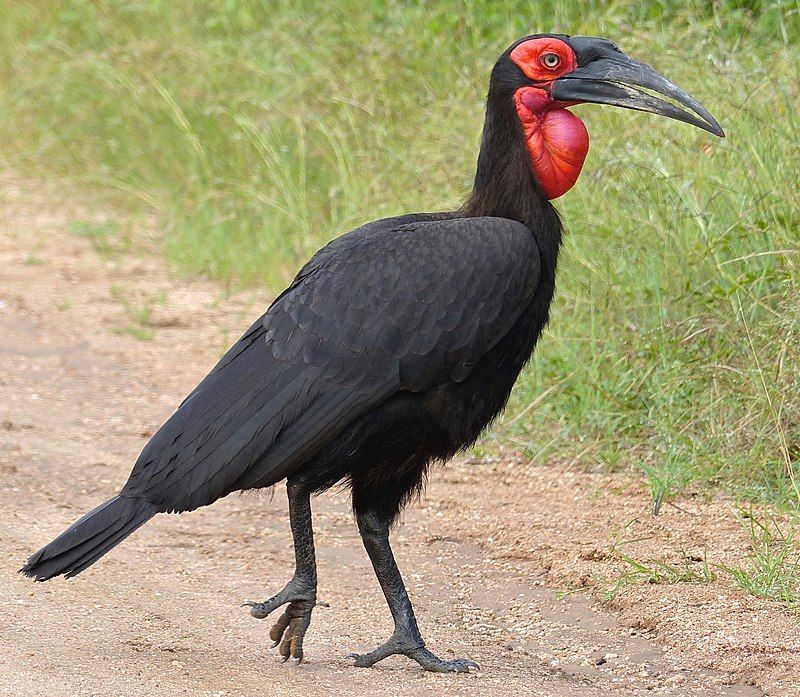
The southern ground hornbill is an impressive bird species that is found exclusively in Africa. It belongs to the hornbill order, and is the biggest of its kind in the world.
This species is mainly found in the southern parts of Africa, ranging from Kenya in the east to South Africa in the south. It is one of two species of ground hornbill, the other being the Abyssinian ground hornbill, which is found in Ethiopia.
The southern ground hornbill is a large bird, with a body length of up to one meter, and a wingspan of nearly two meters. Its plumage is predominantly black, with white patches around the eyes. Its bill is greyish-black and its legs are red.
Its tail is long, with a white tip, and it has a distinctive, loud call that can be heard from quite a distance. The southern ground hornbill is a highly social bird, often found in small groups of two to six birds.
It prefers to live in open woodlands, savannahs and grasslands, but can also be found in forests and mountain areas. It mainly feeds on small mammals, reptiles, insects, and sometimes birds and amphibians. It is an opportunistic feeder, and will also take advantage of carrion.
The southern ground hornbill is a slow breeder, and has a low reproductive rate. It nests in large trees, and both parents take part in the rearing of the young.
It is classified as vulnerable by the IUCN, due to the destruction of its habitats, and is also threatened by hunting. Conservation efforts are in place to help protect this species, and its future looks promising.
| Kingdom | Animalia |
| Phylum | Chordata |
| Class | Aves |
| Order | Bucerotiformes |
| Family | Bucorvidae |
| Genus | Bucorvus |
| Species | B. leadbeateri |
2. Hamerkop
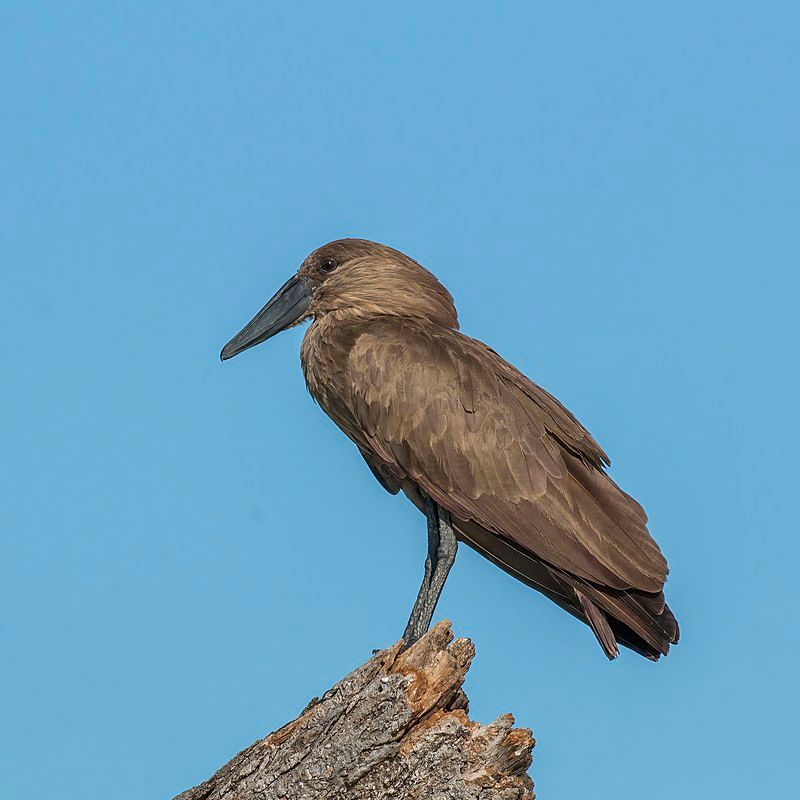
The Hamerkop is a medium-sized bird that belongs to the wading bird family. It is the only living species in the genus Scopus and the family Scopidae.
For a long time, it was believed that the hamerkop belonged to the Ciconiiformes, a family of wading birds that includes storks, herons and ibises. However, it is now placed in the Pelecaniformes, a family of waterbirds that includes pelicans and shoebills.
This suggests that the hamerkop is most closely related to pelicans and shoebills. The hamerkop is an interesting species due to its unique physical characteristics and its isolated position in the avian family tree.
It has a distinctive head shape, long legs and a massive bill, making it easily recognizable amongst other waterbirds. It is also found in a variety of habitats, from wetlands to arid savannahs.
The hamerkop is an important part of many ecosystems, as it helps to keep the environment healthy by eating small aquatic animals and controlling the insect population.
| Kingdom | Animalia |
| Phylum | Chordata |
| Class | Aves |
| Order | Pelecaniformes |
| Family | Scopidae |
| Genus | Scopus |
| Species | S. umbretta |
3. White-Backed Vulture
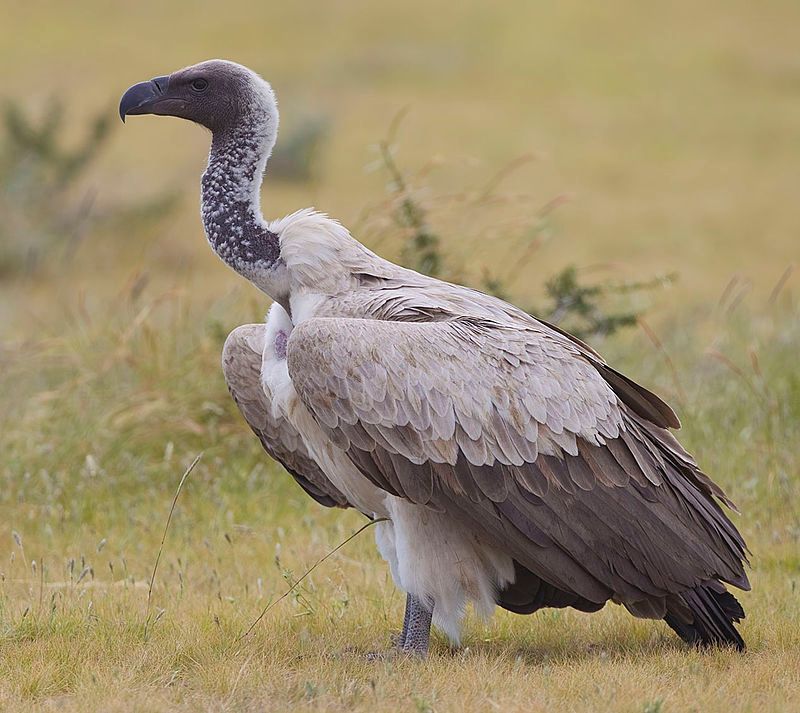
The white-backed vulture is a large bird of prey found in the Old World region. It belongs to the Accipitridae family, which is home to a variety of other birds of prey, such as eagles, kites, buzzards, and hawks.
This species of vulture is the most common in the whole of Africa, and can be found in a wide variety of habitats across the continent. It is an impressive bird, measuring up to 75 cm in length, with a wingspan of up to 2.5 meters.
Its white-feathered back, and distinctive black feathers on its head, neck, and wings make it easily identifiable in the wild. The vulture is an opportunistic scavenger, which means it feeds on carrion, or dead animals.
It can often be seen soaring high above the African savannah, searching for food. This species of vulture is important to the African ecosystem, as it helps to keep the environment clean by consuming dead animals.
As such, it plays an essential role in the food chain, and helps to keep the environment healthy. Despite its importance, the white-backed vulture is facing a number of threats, including habitat destruction, poisoning, and illegal hunting.
Therefore, it is essential that we work to protect this species if we want to ensure its future in Africa.
| Kingdom | Animalia |
| Phylum | Chordata |
| Class | Aves |
| Order | Accipitriformes |
| Family | Accipitridae |
| Genus | Gyps |
| Species | G. africanus |
4. Schalow’s Turaco
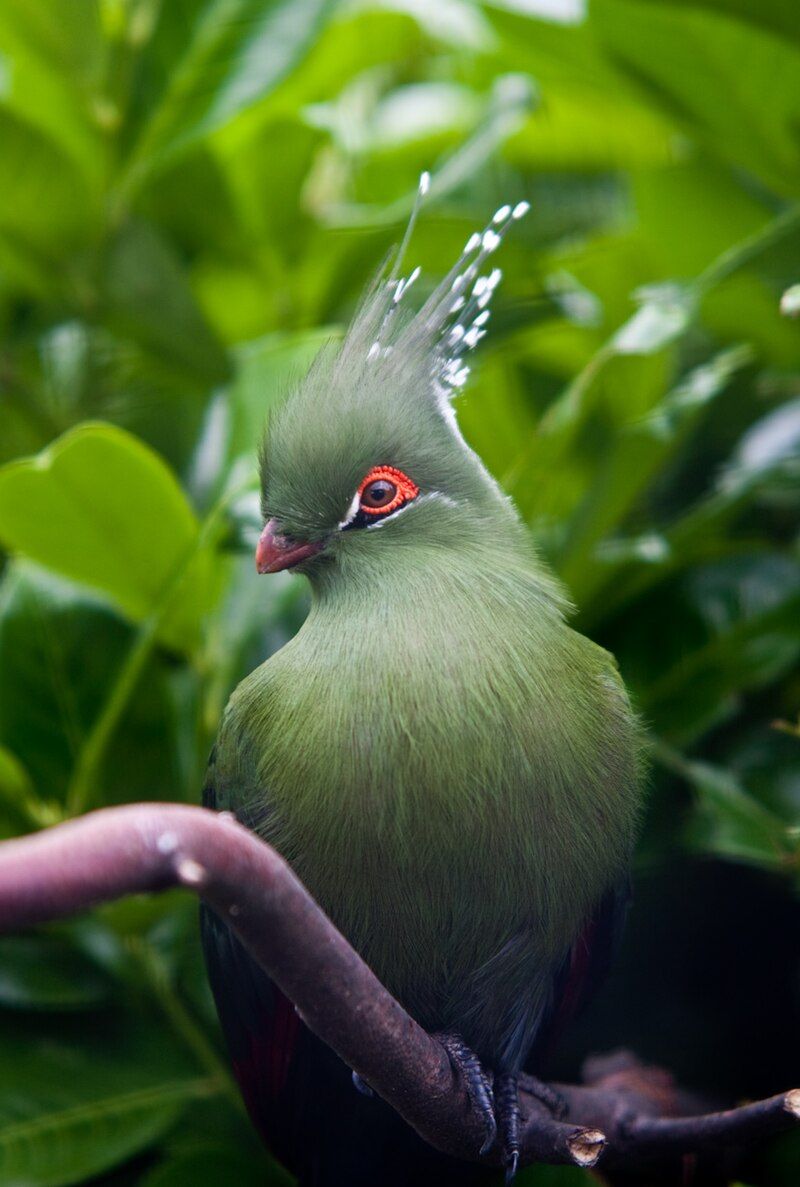
Schalow’s turaco is a species of bird belonging to the family Musophagidae, which is commonly referred to as the plantain-eaters. This bird is native to sub-Saharan Africa and feeds primarily on fruit.
It is distinctive in appearance due to its bright yellow, green, and blue plumage. The species is named after Herman Schalow, a German banker and amateur ornithologist. Schalow was an avid bird collector and was highly respected for his contributions to ornithology.
He collected specimens from around the world, including Africa, and published several papers on the subject. By naming the species after him, Schalow’s turaco is a testament to his dedication to the study of birds.
| Kingdom | Animalia |
| Phylum | Chordata |
| Class | Aves |
| Order | Musophagiformes |
| Family | Musophagidae |
| Genus | Tauraco |
| Species | T. schalowi |
5. Red-Throated Wryneck
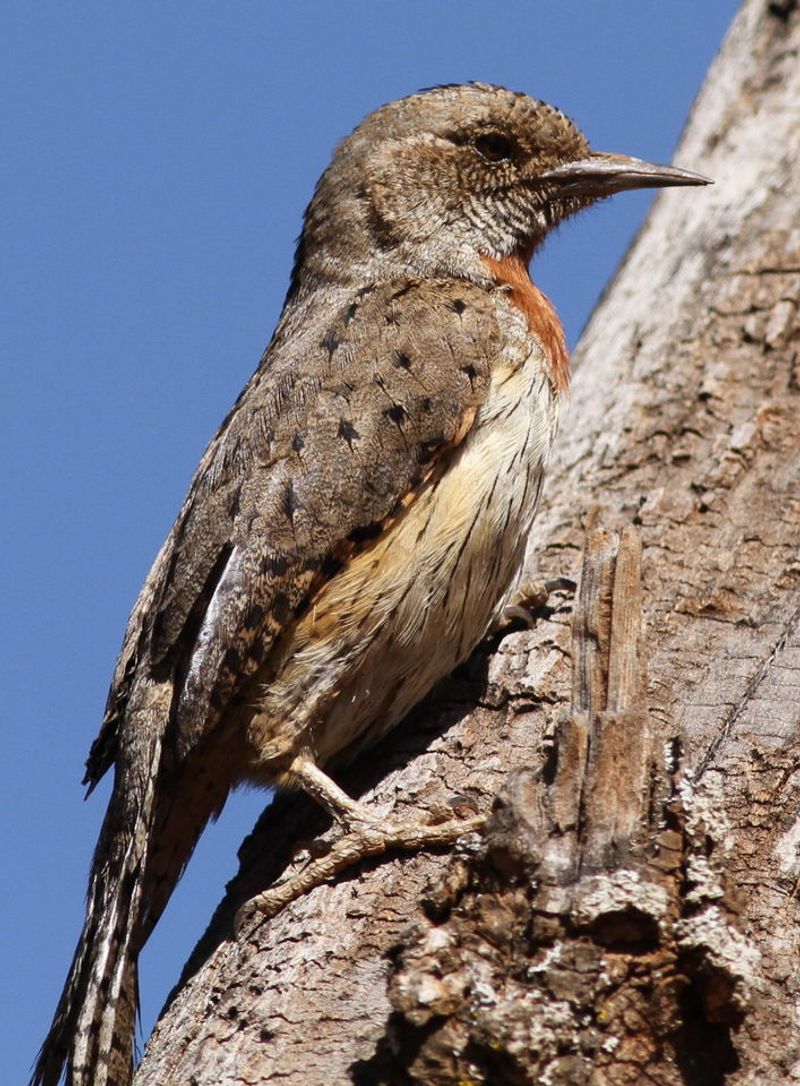
The red-throated wryneck is a species of bird found in the woodpecker family. It is most closely related to the Eurasian wryneck, and has three subspecies. These subspecies are native to much of sub-Saharan Africa, where they live in open habitats with some trees.
The red-throated wryneck is sometimes referred to as the rufous-necked wryneck or the red-breasted wryneck. This species of wryneck has a unique diet, consisting mainly of ants and other small insects.
They have a wide range of vocalizations, and are often heard singing or calling during the day.
The red-throated wryneck is also a social species, often seen in small groups during the breeding season. The red-throated wryneck is a relatively small bird, measuring between 17 and 21 centimeters in length. The male of the species is generally slightly larger than the female.
They have a distinctive red throat and breast, along with a white stripe running across the top of their head. Their wings and tail are brown and barred with black and white stripes. The red-throated wryneck is an important species in the open habitats of sub-Saharan Africa.
They help to control insect populations, and their presence is beneficial to the local ecosystem. Unfortunately, this species is threatened by habitat destruction and other human-related activities.
Conservation efforts are needed to ensure that this species does not become threatened or endangered in the future.
| Kingdom | Animalia |
| Phylum | Chordata |
| Class | Aves |
| Order | Piciformes |
| Family | Picidae |
| Genus | Jynx |
| Species | J. ruficollis |
6. Grey-Headed Kingfisher
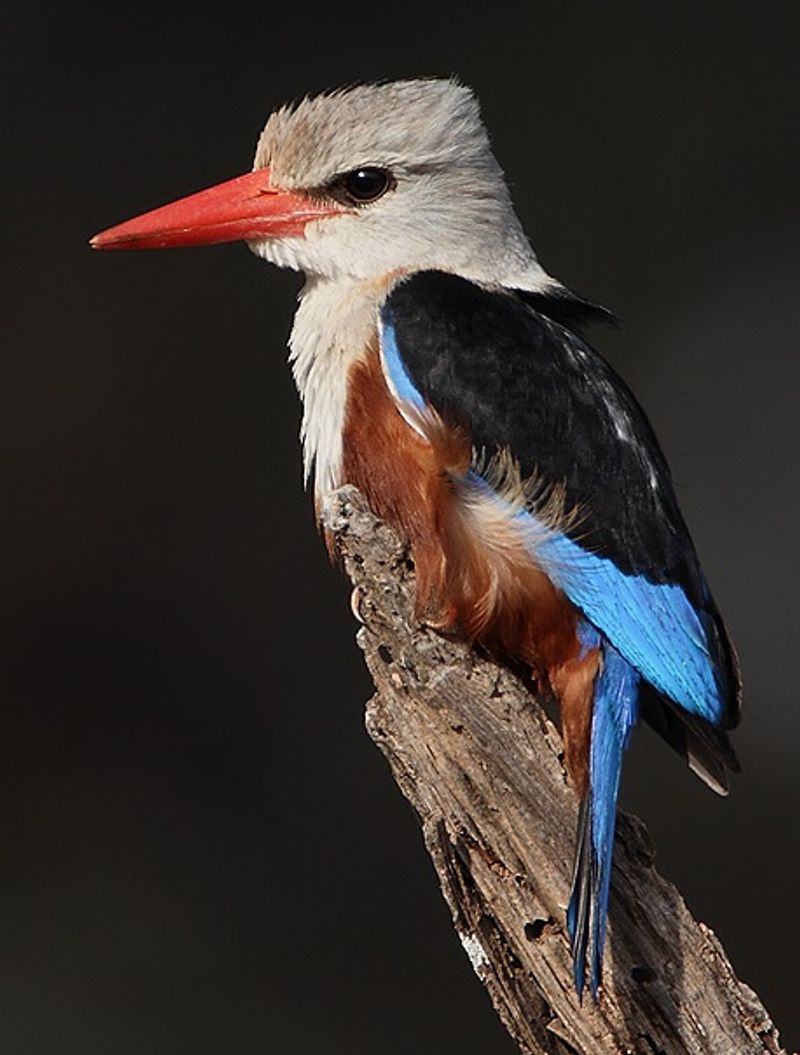
The grey-headed kingfisher is a species of kingfisher that has an impressive range of distribution. It can be found from the Cape Verde Islands off the north-west coast of Africa, stretching east to Ethiopia, Somalia and southern Arabia.
The species is also found in Mauritania, Senegal and Gambia, and even as far south as South Africa. This species of kingfisher is particularly interesting because of its wide range of distribution.
While it is typically found in tropical and subtropical regions, it can also be found in more temperate areas.
This is likely due to its ability to adapt to different climates and habitats, allowing it to thrive in a variety of locations. The grey-headed kingfisher is a medium-sized bird, with a grey crown, white neck and chest and a rusty-orange belly.
Its wings and tail are boldly patterned with black and white, while its bill is long and pointed.
It is an active bird and can often be seen perching on branches or flying low over water. The grey-headed kingfisher is omnivorous, feeding on insects, fish, frogs, lizards and even small mammals and birds.
It is a solitary bird and typically nests in tree cavities or on the ground. The species is not considered threatened and its population is considered to be stable.
| Kingdom | Animalia |
| Phylum | Chordata |
| Class | Aves |
| Order | Coraciiformes |
| Family | Alcedinidae |
| Genus | Halcyon |
| Species | H. leucocephala |
7. Abdim’s Stork
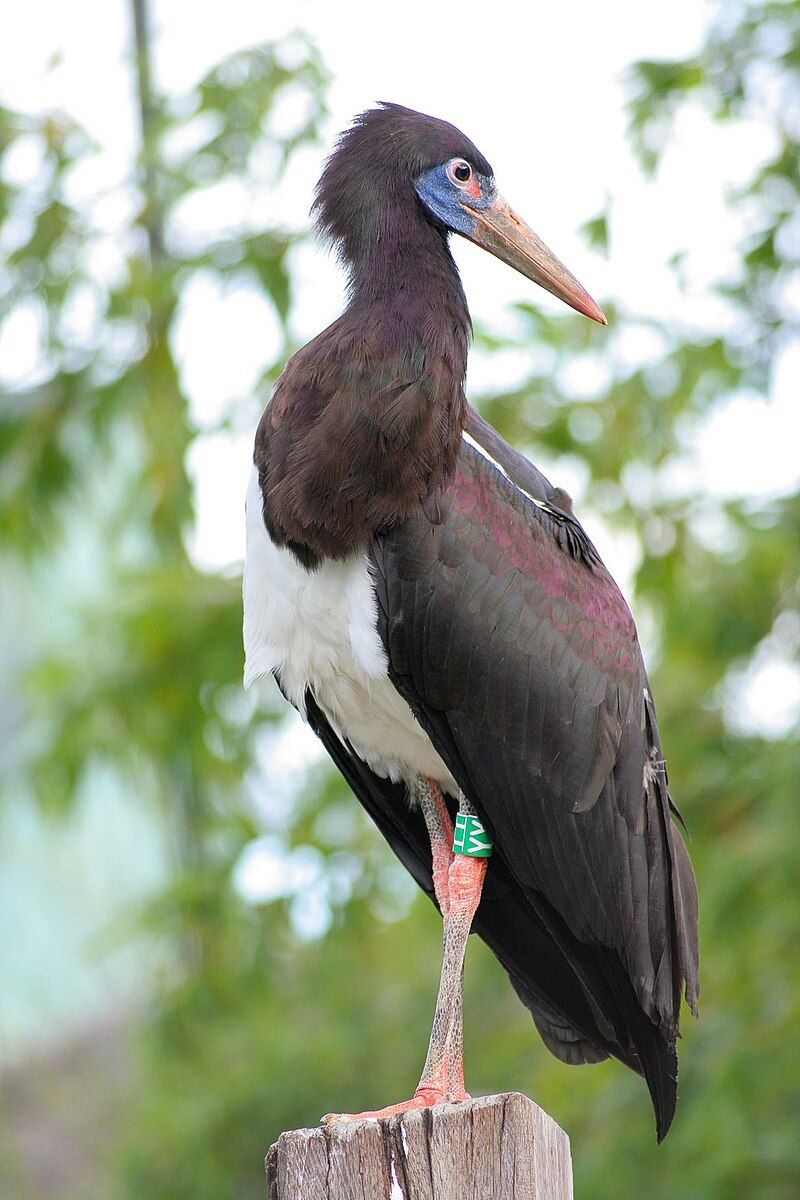
Abdim’s stork, scientifically known as the Ciconiidae stork, is a unique species of stork that is the smallest of its kind. This species of stork is found in open habitats across Sub-Saharan Africa and in Yemen. It has a white belly, which gives it its common name.
The Abdim’s stork is an insectivore, meaning it primarily feeds on insects. This type of diet allows it to live in a variety of habitats, as insects are found in most open areas. These birds are also known to feed on small mammals, reptiles, amphibians, and fish.
The Abdim’s stork is a fascinating species of bird and is known for its unique behavior. It is known to use a variety of techniques to capture its prey, such as using its long bill to catch insects or even using its wings to create a “net” in order to catch them.
It is also capable of hovering in the air for extended periods of time in order to search for food. The Abdim’s stork is an important part of the African ecological system and is a vital part of the food chain.
Its unique and fascinating behavior makes it an interesting species to observe and learn more about.
| Kingdom | Animalia |
| Phylum | Chordata |
| Class | Aves |
| Order | Ciconiiformes |
| Family | Ciconiidae |
| Genus | Ciconia |
| Species | C. abdimii |
8. Grey-Crowned Crane
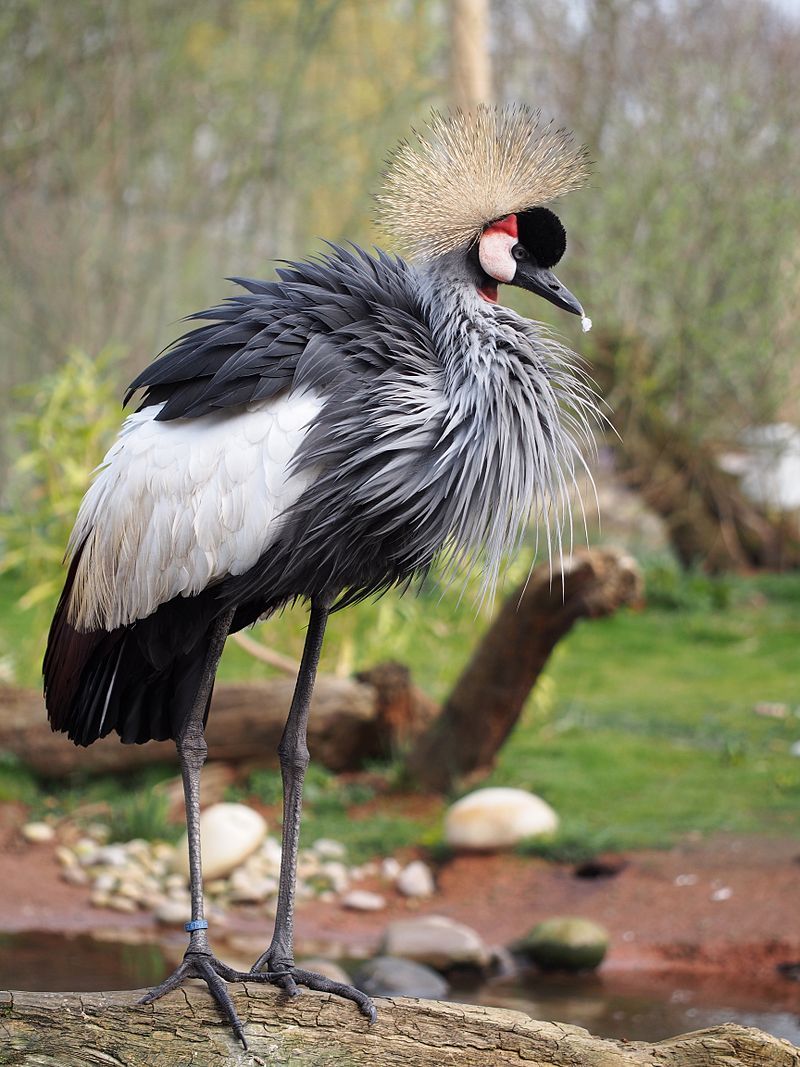
The Grey Crowned Crane is a species of bird that belongs to the family of Gruidae, which is more commonly referred to as the crane family.
This species of bird is known by a variety of different names, including African Crowned Crane, Golden Crested Crane, Golden Crowned Crane, East African Crane, East African Crowned Crane, African Crane, Eastern Crowned Crane, Kavirondo Crane, South African Crane and Crested Crane.
This species of bird is found in many African countries, including Uganda, Kenya, Tanzania, Zambia, Botswana and Zimbabwe. It is a striking and impressive bird, with a greyish-brown body plumage and a distinctive golden crown.
The Grey Crowned Crane is a highly social bird, living in large flocks and often gathering in large numbers at wetland areas. They are omnivorous, feeding on a range of insects, invertebrates, grains, seeds, fruit, roots, tubers and small vertebrates.
The Grey Crowned Crane is considered to be an important species in terms of cultural significance in many African countries, and is commonly depicted in art, literature, music and folklore.
| Kingdom | Animalia |
| Phylum | Chordata |
| Class | Aves |
| Order | Gruiformes |
| Family | Gruidae |
| Genus | Balearica |
| Species | B. regulorum |
9. African Olive Pigeon
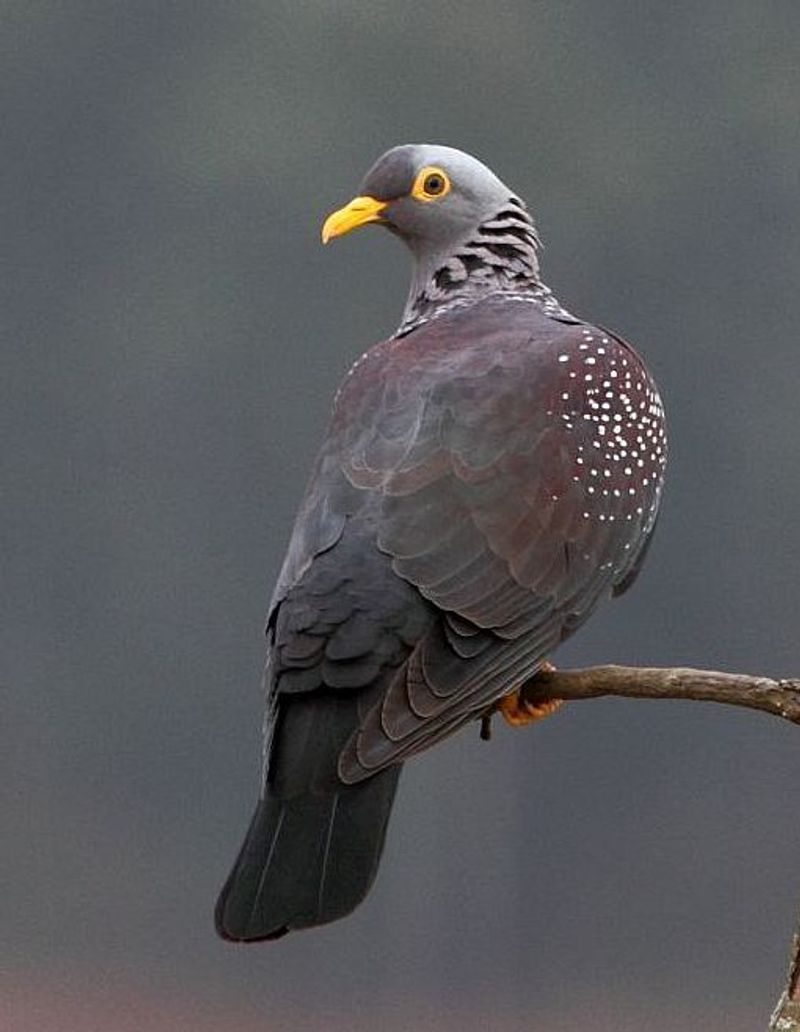
The African olive pigeon, also known as the Rameron pigeon, is a species of bird that is native to eastern and southern Africa. It is a resident breeding bird in many parts of the region, extending from Ethiopia to the Cape.
In addition, there are also populations of African olive pigeons in western Angola, southwestern Saudi Arabia, and northern Yemen. The African olive pigeon is a medium-sized bird, usually measuring between 30 and 35 cm in length.
It is primarily grey in colour, with a darker head and lighter underparts. It has a distinctive white collar around the neck, and a white patch on the lower back.
The wings are also flecked with white, which makes the bird easily identifiable in flight. The African olive pigeon feeds mainly on grain and seeds, although it will occasionally eat fruits and insects as well.
It typically nests in trees, although it also builds nests in rock crevices or other sheltered locations.
It typically lays two eggs at a time, which hatch after an incubation period of two to three weeks. The African olive pigeon is an important species in its native habitat, as it helps to disperse the seeds of various plant species, aiding in the regeneration of vegetation.
In addition, the bird is hunted by local people for food, and is also kept as a pet in some parts of its range.
| Kingdom | Animalia |
| Phylum | Chordata |
| Class | Aves |
| Order | Columbiformes |
| Family | Columbidae |
| Genus | Columba |
| Species | C. arquatrix |
10. Saddle-Billed Stork
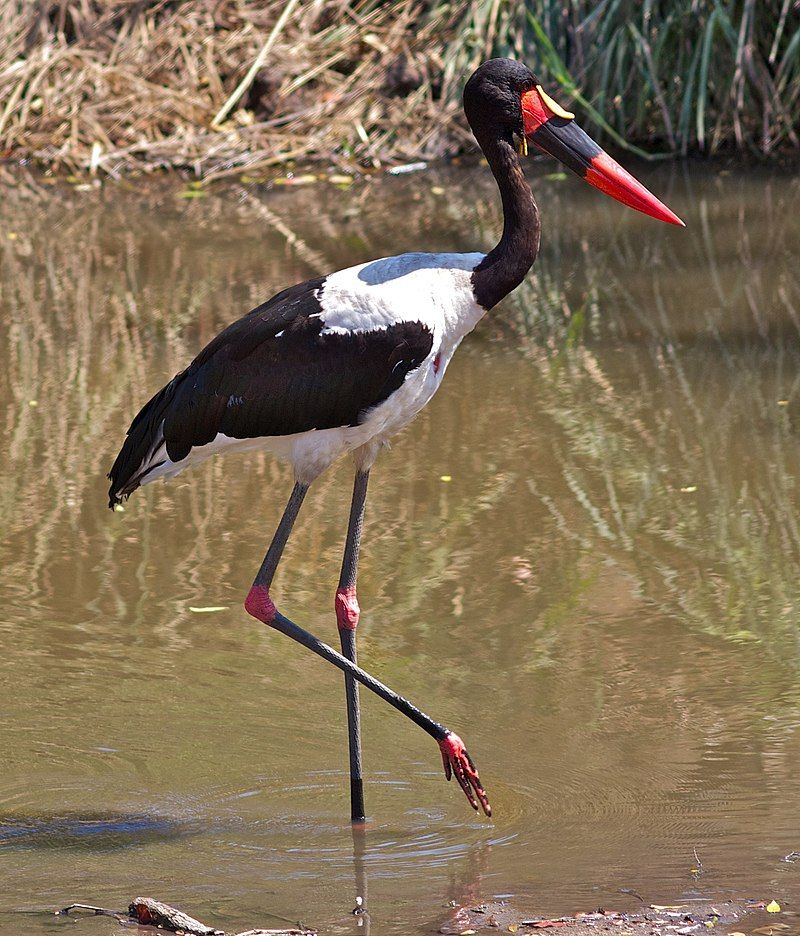
The saddle-billed stork is a large wading bird belonging to the stork family (Ciconiidae). It is found in a wide range of areas, from sub-Saharan Africa to The Gambia, Senegal, Côte d’Ivoire and Chad in West Africa.
In sub-Saharan Africa, the saddle-billed stork is a resident breeder, meaning that it lives and breeds in the same area. This species is found from Sudan, Ethiopia and Kenya in the north, all the way down to South Africa in the south.
The saddle-billed stork is an impressive bird, with a distinct saddle-shaped bill, long legs, and a large wingspan. It can often be seen standing tall in shallow waters, patiently waiting for prey.
This species feeds mainly on fish, frogs, insects and small reptiles such as lizards. With its widespread range, the saddle-billed stork is an important part of many different ecosystems and plays an important role in the food chain.
| Kingdom | Animalia |
| Phylum | Chordata |
| Class | Aves |
| Order | Ciconiiformes |
| Family | Ciconiidae |
| Genus | Ephippiorhynchus |
| Species | E. senegalensis |
11. Temminck’s Courser
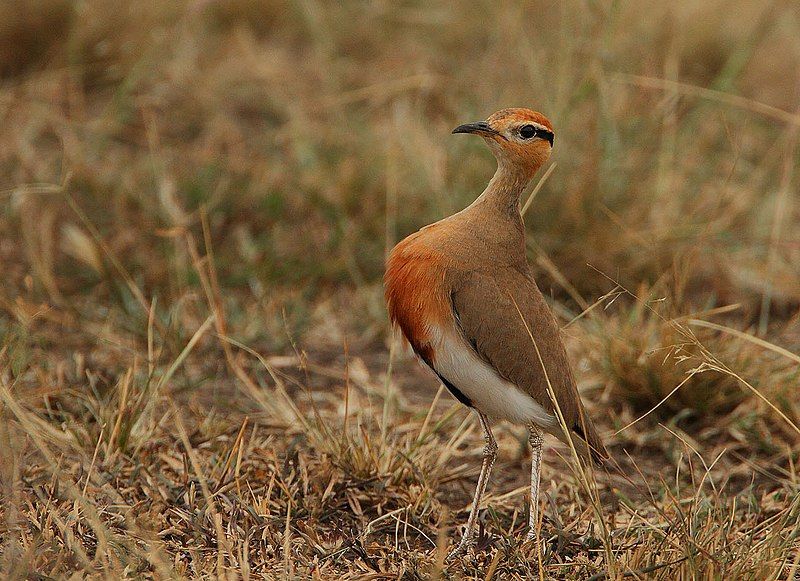
Temminck’s courser is a species of bird belonging to the pratincole and courser family, Glareolidae. This species of bird is a wader, meaning it lives in wet and marshy areas, and is found in sub-Saharan Africa.
It is known for its unique behavior of laying its dark ash-black eggs in the burnt bushes and grass of the African savannah. This behavior is thought to be an adaptation to the dry environment, as the burnt grass and bushes provide more insulation and heat than fresh vegetation.
The birds may also be trying to camouflage their eggs, as the charred color of the eggs blends in with the landscape. Additionally, the eggs may be less vulnerable to predators in this environment.
The Temminck’s courser is an important part of the African savannah ecosystem, and its eggs provide an important source of nutrition for other animals that feed on them.
| Kingdom | Animalia |
| Phylum | Chordata |
| Class | Aves |
| Order | Charadriiformes |
| Family | Glareolidae |
| Genus | Cursorius |
| Species | C. temminckii |
12. Giant Kingfisher
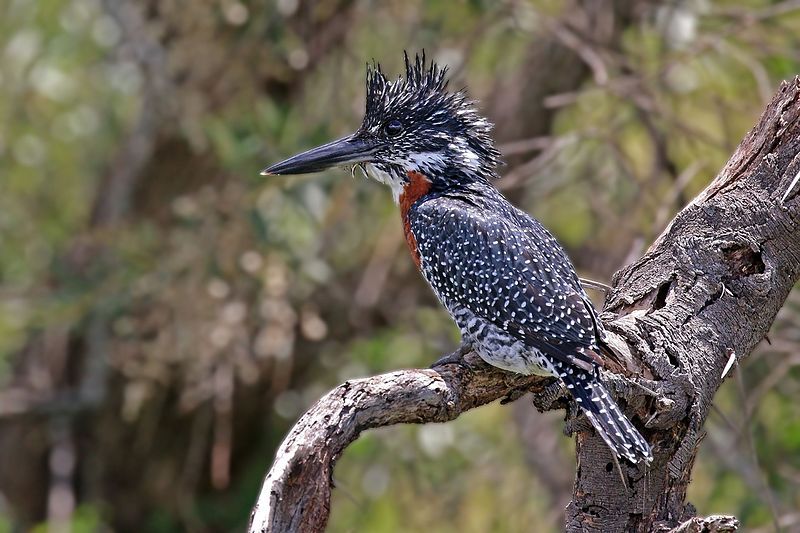
The giant kingfisher is an impressive bird found in Africa. It is the biggest kingfisher on the continent and is found in most parts of Africa south of the Sahara Desert. The arid southwest is the only region in which the bird does not reside and breed.
This kingfisher is known for its large size and majestic appearance, as well as its bright colors, which include deep blues, purples, and reds.
Its eyes are a bright yellow, and its heavy beak is black. The giant kingfisher is a solitary bird, but can be seen gathering in flocks around rivers and other bodies of water. It feeds mostly on fish, but will also consume frogs, insects, small reptiles, and even small mammals.
It will perch on branches or rocks near the water, and then dive down to snatch its prey. The giant kingfisher makes its nest inside cavities in trees, where it lays anywhere from two to seven eggs.
The female will incubate the eggs during the day, while the male takes over during the night. Both parents care for the young when they hatch. The giant kingfisher is a fascinating species of bird with a powerful presence in Africa.
Its large size and bright colors make it easy to spot, and its predatory behavior is something to behold.
Its presence in most of Africa south of the Sahara Desert is a testament to its adaptability and survival skills, and it will no doubt continue to thrive in the years to come.
| Kingdom | Animalia |
| Phylum | Chordata |
| Class | Aves |
| Order | Coraciiformes |
| Family | Alcedinidae |
| Genus | Megaceryle |
| Species | M. maxima |
13. African Jacana
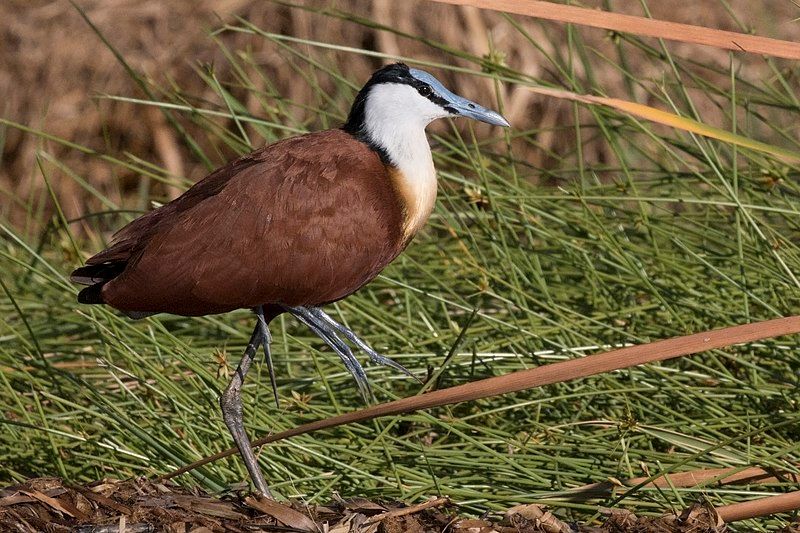
The African jacana is a wading bird that belongs to the family Jacanidae. It is native to sub-Saharan Africa and is known for its incredible ability to walk on floating vegetation in shallow lakes.
This is possible due to its long toes and long claws, which allow it to grip onto the vegetation and remain balanced. The African jacana is a fairly large bird, measuring about 25–30 cm in length.
It has a brownish-black back and wings with white and chestnut stripes along its body. Its head and neck are mostly white with a black crest on its forehead.
The African jacana has a distinctive black bill and bright yellow legs. The African jacana’s preferred habitat is shallow lakes, ponds and marshes with plenty of floating vegetation. It feeds on small aquatic insects such as beetles, damselflies and dragonflies.
It can also eat small crustaceans, mollusks, frogs and fish. The African jacana is a territorial bird, and it will defend its territory from other birds. It is a monogamous species with pairs often staying together for life.
The female is responsible for laying the eggs and caring for the chicks, while the male helps to protect the nest. The African jacana is a widespread species and can be found in many parts of sub-Saharan Africa.
It is classified as of least concern by the IUCN, as its population is considered to be stable.
| Kingdom | Animalia |
| Phylum | Chordata |
| Class | Aves |
| Order | Charadriiformes |
| Family | Jacanidae |
| Genus | Actophilornis |
| Species | A. africanus |
14. Little Stint
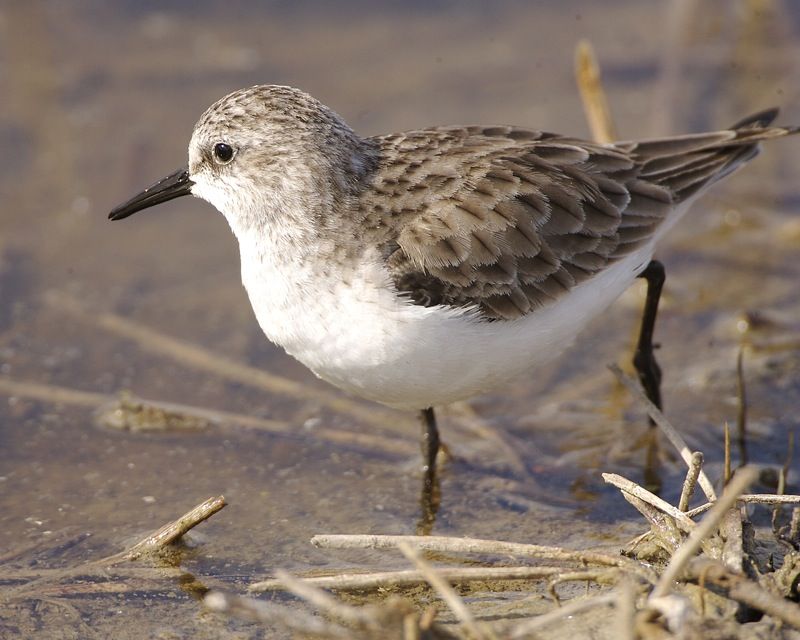
The little stint is a very small wader, a type of shorebird, which breeds in arctic regions of Europe and Asia. It is a remarkable long-distance migrant, travelling south to Africa and South Asia during winter.
It is an uncommon occurrence for the little stint to be seen in North America and Australia as a vagrant. This means that it rarely appears there outside of its normal range, most likely due to being blown off course during its long migrations.
The little stint is a remarkable species with impressive migratory patterns, and its presence in North America and Australia is a special treat.
| Kingdom | Animalia |
| Phylum | Chordata |
| Class | Aves |
| Order | Charadriiformes |
| Family | Scolopacidae |
| Genus | Calidris |
| Species | C. minuta |
15. White-Faced Whistling Duck
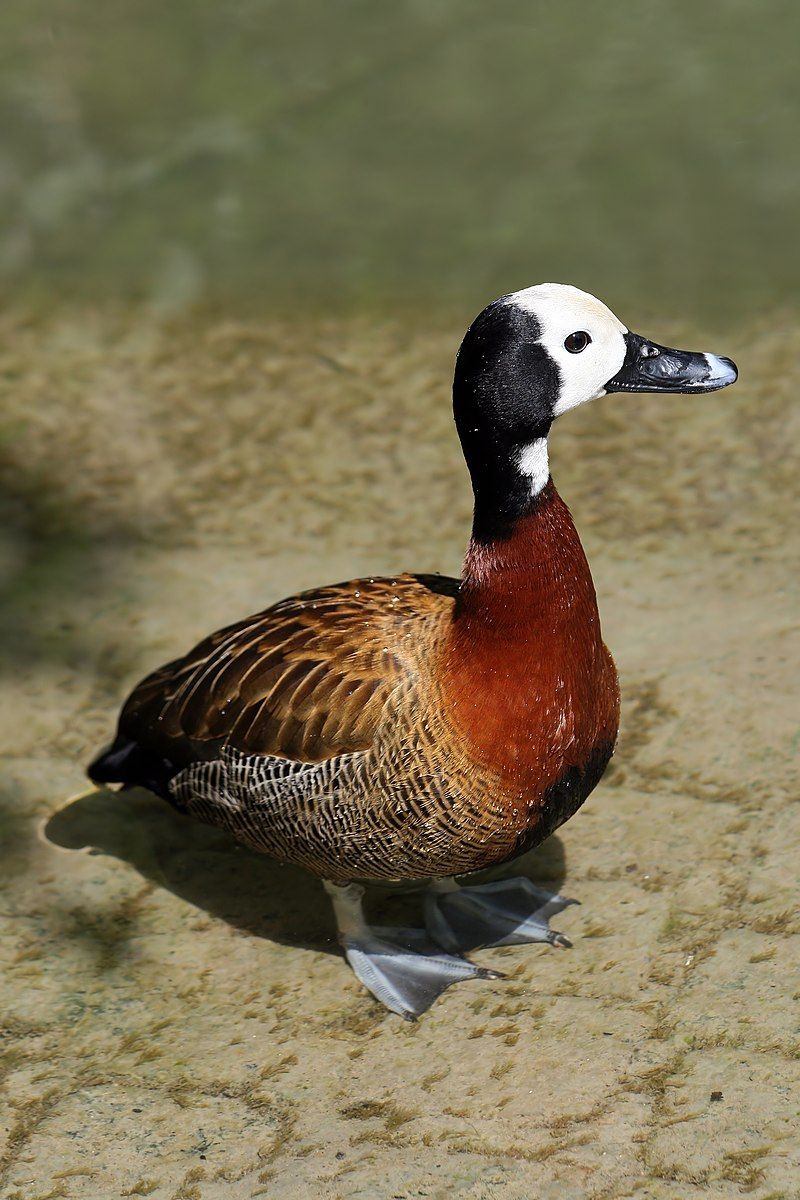
The white-faced whistling duck is a species of whistling duck that is found in sub-Saharan Africa and much of South America. This species of duck is known for being very social and often forms large flocks.
These flocks can be quite a spectacle, with some numbering up to a thousand birds. It is most common to see these flocks gathering at dawn, as they come together to start their day. The sight of such a large group of these birds arriving together is truly breathtaking.
The white-faced whistling duck feeds on aquatic plants, seeds, and invertebrates. These ducks are very vocal and will often make whistling sounds as they fly. They have long legs and can be seen wading in shallow waters.
The white-faced whistling duck is also known for being a good swimmer and can spend long periods of time in the water. The white-faced whistling duck is an important species of duck in many parts of the world.
It is a key part of the food chain, and its presence helps to maintain a healthy ecosystem. The duck is also popular with birdwatchers, as it is a fairly easy species to identify and observe.
Overall, the white-faced whistling duck is an interesting and important species of duck. Its large flocks are a stunning sight and its presence is beneficial to the environment.
| Kingdom | Animalia |
| Phylum | Chordata |
| Class | Aves |
| Order | Anseriformes |
| Family | Anatidae |
| Genus | Dendrocygna |
| Species | D. viduata |
16. African Green Pigeon
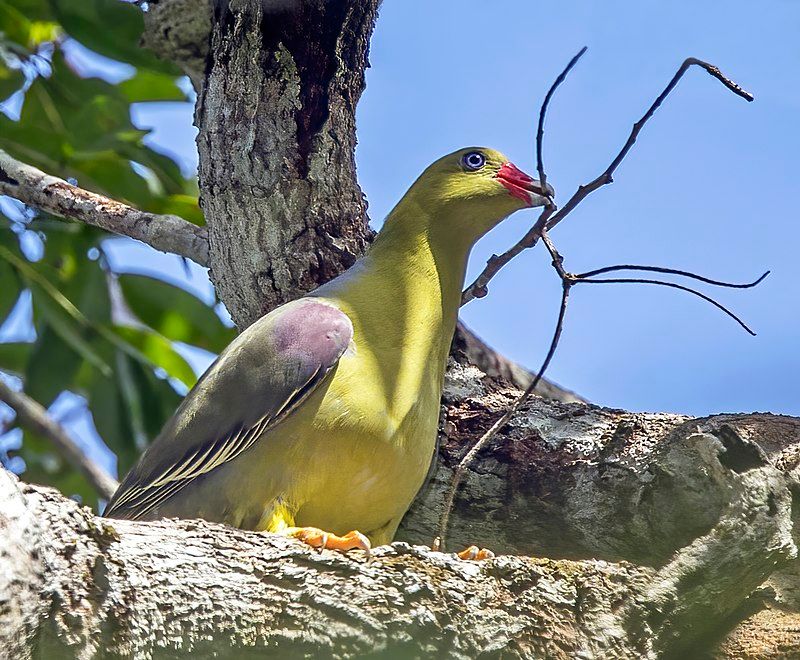
The African green pigeon is a species of bird that belongs to the Columbidae family. This species is one of five green pigeon species that are native to the Afrotropics. It has a wide range of distribution in Sub-Saharan Africa, with some 17 accepted races.
This species of green pigeon is found in various habitats such as woodlands, open savannas, and coastal areas. It feeds mainly on fruits, which makes it an important seed disperser in the African savanna.
The African green pigeon is an all-year resident and usually seen in small groups or pairs. It is a relatively small species, with males measuring between 25–27 cm in length, and females measuring around 26–28 cm in length.
This species is highly adaptable to different environments and is not currently considered to be threatened or endangered.
| Kingdom | Animalia |
| Phylum | Chordata |
| Class | Aves |
| Order | Columbiformes |
| Family | Columbidae |
| Genus | Treron |
| Species | T. calvus |
17. Water Thick-Knee
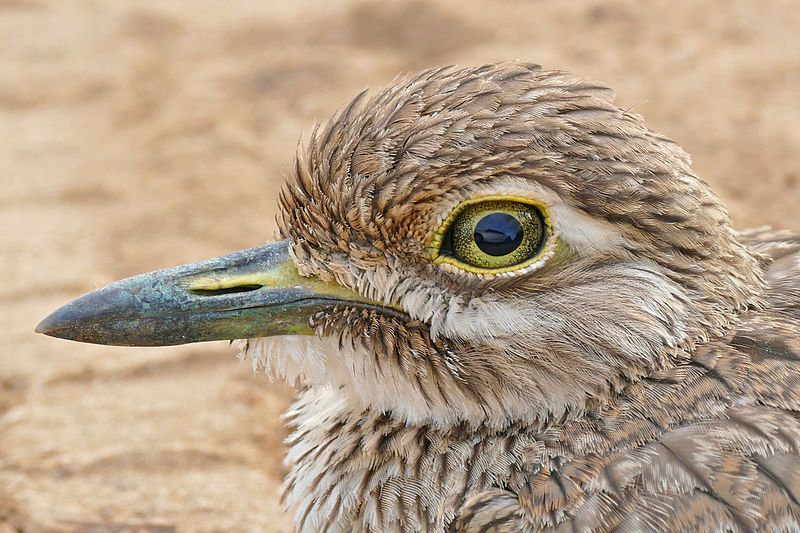
The water thick-knee, or water dikkop, is a species of bird belonging to the family Burhinidae. This family of birds is also known as thick-knees, due to the thickened areas on their legs which give them their characteristic name.
The water thick-knee is native to sub-Saharan Africa and is usually found in proximity to water sources such as lakes, rivers, streams, and ponds.
This species of bird is a wader, so it spends most of its time on the ground in search of food such as insects, small crabs, and mollusks. The water thick-knee has a distinctive appearance, with a brownish-gray body, white stripes on its wings, and a long bill.
It also has a long neck and a large head, which helps it to spot potential food sources from a distance. Its legs are thickened and covered in dense feathers, helping it to move easily through water and mud.
The species is usually seen in pairs, but it can also form small groups when foraging for food. The water thick-knee is an important part of the ecosystem in sub-Saharan Africa, as it helps to maintain the balance of the food chain by preying on smaller animals such as insects and crustaceans.
It is also a popular bird among birdwatchers, as it is relatively easy to spot and observe in its natural habitat.
| Kingdom | Animalia |
| Phylum | Chordata |
| Class | Aves |
| Order | Charadriiformes |
| Family | Burhinidae |
| Genus | Burhinus |
| Species | B. vermiculatus |
18. Gull-Billed Tern
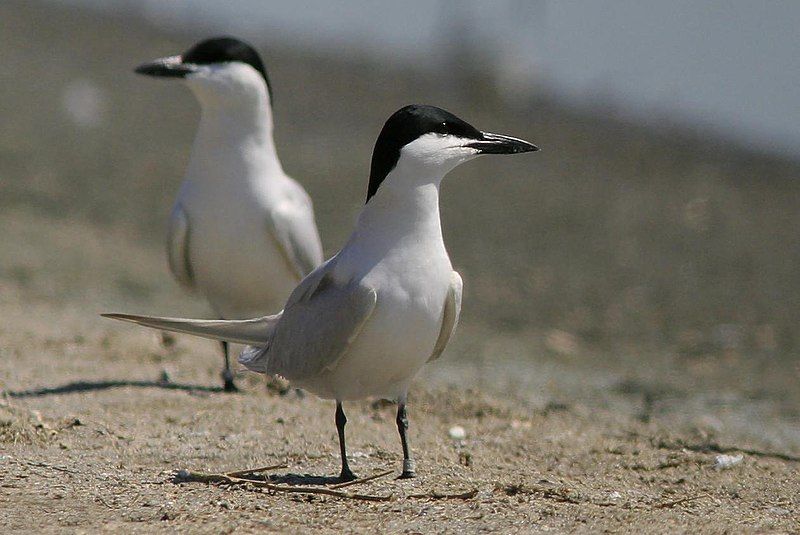
The gull-billed tern is a species of bird belonging to the family Laridae, which includes many other seabirds such as gulls, skimmers, and terns. It was formerly known as Sterna nilotica and is found across many parts of the world.
It breeds in Europe, Asia, northwest Africa, and the Americas, although its distribution is somewhat scattered.
The Australian gull-billed tern was previously classified as a subspecies, though this has since been changed.The gull-billed tern is easily recognizable due to its distinctive black-and-white plumage and forked tail.
It is a medium-sized bird, with a wingspan of around 40 cm and a weight of around 120 g. Its bill is thick and hooked, and it has a short neck and a short, broad tail.
It feeds mainly on fish, which it catches by hovering over water and dipping its bill into the water to snatch its prey. The gull-billed tern is a sociable bird, often seen in large flocks.
During the breeding season, pairs will build nests close to water sources, mainly in coastal areas. The female lays two to four eggs in each clutch, which are incubated for around twenty-four days.
Both parents are involved in caring for the young, which fledge after around forty days. The gull-billed tern is not considered to be threatened, although some regional populations have declined due to habitat destruction and human disturbance.
This species is protected under the Agreement on the Conservation of African-Eurasian Migratory Waterbirds, and conservation measures are in place to ensure its continued survival.
| Kingdom | Animalia |
| Phylum | Chordata |
| Class | Aves |
| Order | Charadriiformes |
| Family | Laridae |
| Genus | Gelochelidon |
| Species | G. nilotica |
19. Woolly-Necked Stork
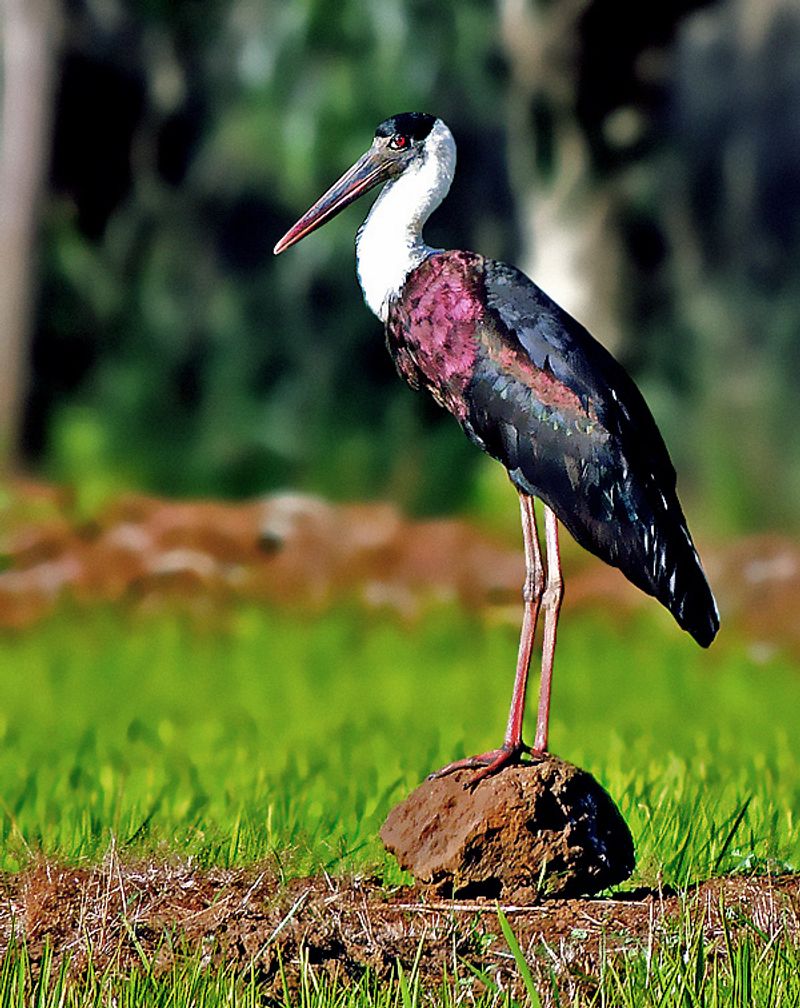
The Asian woolly-necked stork is a species of large bird that belongs to the Ciconiidae family. It usually breeds alone or in small, loosely formed colonies.
This species is found in a wide variety of habitats, including marshes, forests, agricultural areas, and freshwater wetlands in Asia. This bird is a wading species, meaning it prefers to forage in shallow water, searching for food such as fish, amphibians, and crustaceans.
It also scavenges for carrion and sometimes feeds on small mammals, reptiles, and insects. Its conservation status is vulnerable, with its population declining due to increasing agricultural activities and the destruction of its habitat.
Conservation efforts have been put in place in some areas to help protect the species, such as creating protected areas and providing alternative food sources.
| Kingdom | Animalia |
| Phylum | Chordata |
| Class | Aves |
| Order | Ciconiiformes |
| Family | Ciconiidae |
| Genus | Ciconia |
| Species | C. episcopus |
20. Black-Chested Snake Eagle
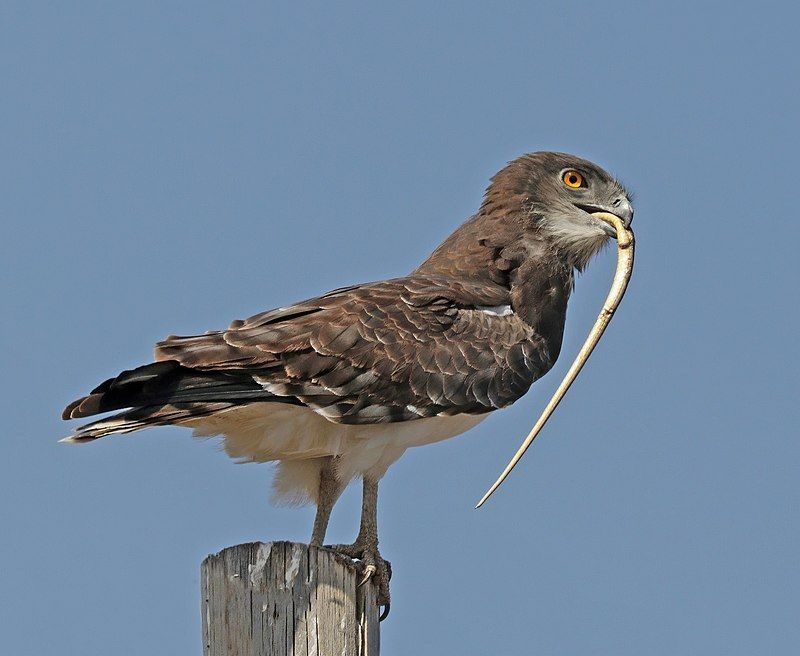
The black-chested snake eagle is a large bird of prey native to Africa, belonging to the Accipitridae family. It has a black chest and a white underside, giving it a striking appearance. Its feathers are long and curved, and its beak is hooked like other snake eagles.
It has a wingspan of up to 5 feet and is known for its impressive soaring and gliding abilities. The black-chested snake eagle is closely related to the short-toed and Beaudouin’s snake eagles, and in the past was considered to be the same species.
It is an opportunistic predator, feeding on small to mid-sized animals such as rodents, reptiles, amphibians and even small birds. It is an important part of the African ecosystem and plays an important role in maintaining the balance of its environment.
| Kingdom | Animalia |
| Phylum | Chordata |
| Class | Aves |
| Order | Accipitriformes |
| Family | Accipitridae |
| Genus | Circaetus |
| Species | C. pectoralis |
21. Tawny Eagle
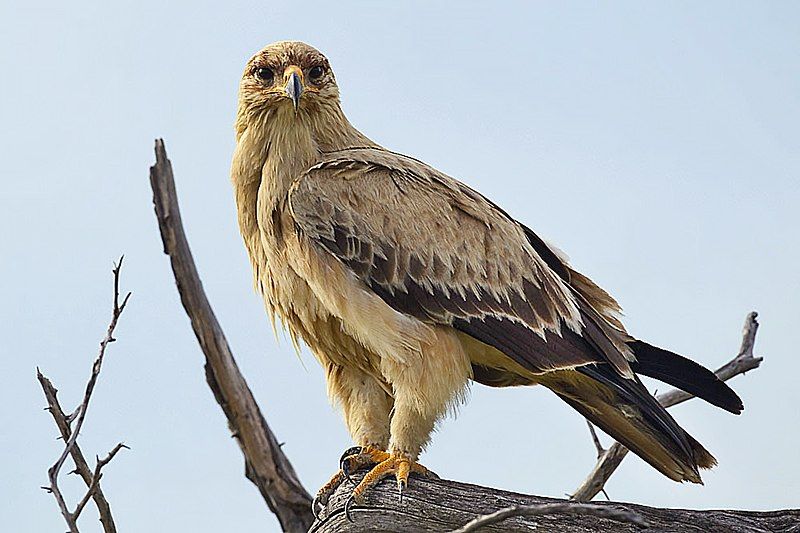
The tawny eagle is a majestic bird of prey belonging to the family Accipitridae. This species of eagle can be easily recognized by its heavily feathered legs which mark it as a member of the subfamily Aquilinae, also known as booted eagles.
With a wingspan of approximately two meters, the tawny eagle is one of the larger birds of prey and is often seen soaring high in the sky.
It is a powerful hunter, capable of taking down a wide variety of small mammals and birds. Tawny eagles typically inhabit open woodlands, grasslands, and semi-arid regions. They are generally found in pairs, hunting together during the day and roosting together at night.
They build loosely constructed nests from sticks and twigs and lay around two eggs per clutch.
The chicks are cared for by both parents and will reach maturity after two to three years. Though the tawny eagle’s population is not currently threatened, it is vulnerable to habitat destruction, human disturbance, and illegal hunting.
As such, conservation efforts are essential to ensure the species’ continued survival. Research is also needed to better understand the species’ nesting habits, breeding behavior, and ecology.
| Kingdom | Animalia |
| Phylum | Chordata |
| Class | Aves |
| Order | Accipitriformes |
| Family | Accipitridae |
| Genus | Aquila |
| Species | A. rapax |
22. Rufous-Naped Lark
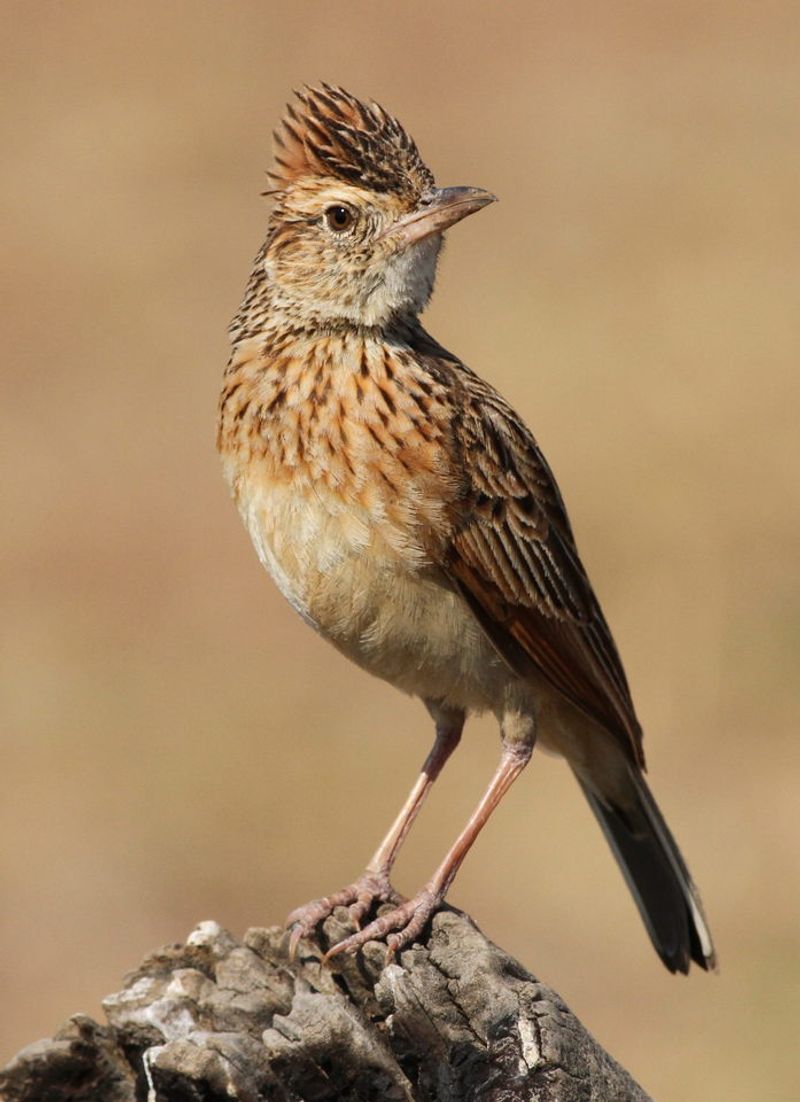
The Rufous-naped Lark, also known as the Rufous-naped Bush Lark, is a species of lark found in parts of the Afrotropics. This species of lark is quite common and is known to inhabit lightly wooded grasslands, open savannas, and farmlands.
The Rufous-naped Lark is quite hardy and is able to survive in a variety of habitats, which is why it is so widespread. This species of lark is easily recognizable due to its distinct rufous coloration on its nape, or neck area.
Additionally, this species of lark is known to be quite conspicuous due to its loud call and its tendency to fly in large groups. The Rufous-naped Lark is a relatively small bird, measuring approximately 16 cm in length.
It feeds mainly on insects, seeds, and berries, and is known to nest on the ground. Overall, the Rufous-naped Lark is a species of lark that is quite common and widespread in the Afrotropic region.
This species of lark is easily recognizable due to its distinct coloration, and is known to inhabit lightly wooded grasslands, open savannas, and farmlands.
The Rufous-naped Lark is a relatively small bird that feeds mainly on insects, seeds, and berries, and is also known to fly in large groups.
| Kingdom | Animalia |
| Phylum | Chordata |
| Class | Aves |
| Order | Passeriformes |
| Family | Alaudidae |
| Genus | Mirafra |
| Species | M. africana |
23. Spotted Thick-Knee
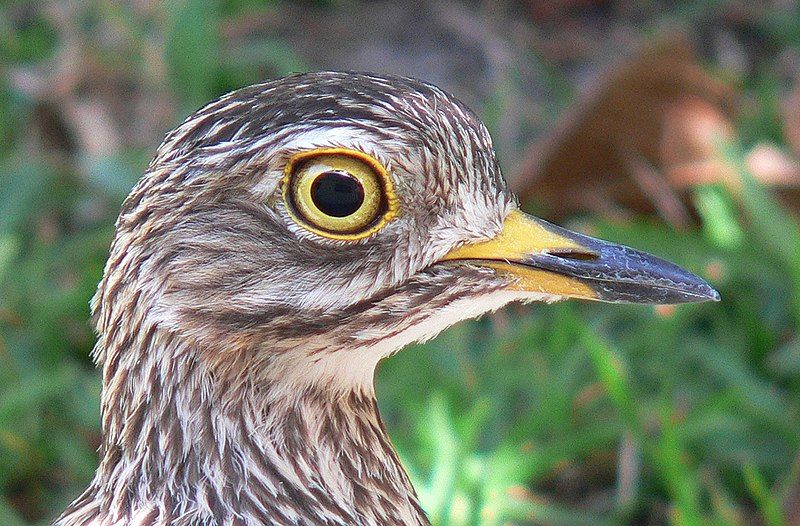
The spotted thick-knee is an interesting bird species belonging to the family Burhinidae. It is native to tropical regions of central and southern Africa and is commonly referred to as the spotted dikkop or Cape thick-knee.
It is a wader, meaning that it is typically found in shallow bodies of water like wetlands, marshes, and mudflats. The spotted thick-knee is a medium-sized bird, with males reaching lengths of approximately 26 centimeters and females measuring 24 centimeters.
Its plumage is predominantly a sandy color, with black and white spots on its back and wings. Its legs are thick and strong and are a yellowish color, while its bill is long and curved. The spotted thick-knee is a ground-dwelling bird that prefers to forage in open grassland.
It feeds primarily on insects and other small invertebrates, making it an important part of the food chain in its native habitat. It is also known to eat small rodents, reptiles, and amphibians. The spotted thick-knee is a social creature, often seen in pairs or small groups.
It is an active bird, often seen running and hopping along the ground in search of food.
It is an excellent flyer and can be seen soaring across the sky in search of food. The spotted thick-knee is an important species in its native habitat, playing an important role in maintaining the balance of the ecosystem.
It is considered to be of least concern by the IUCN, meaning that it is not currently threatened with extinction.
| Kingdom | Animalia |
| Phylum | Chordata |
| Class | Aves |
| Order | Charadriiformes |
| Family | Burhinidae |
| Genus | Burhinus |
| Species | B. capensis |
24. Striped Kingfisher
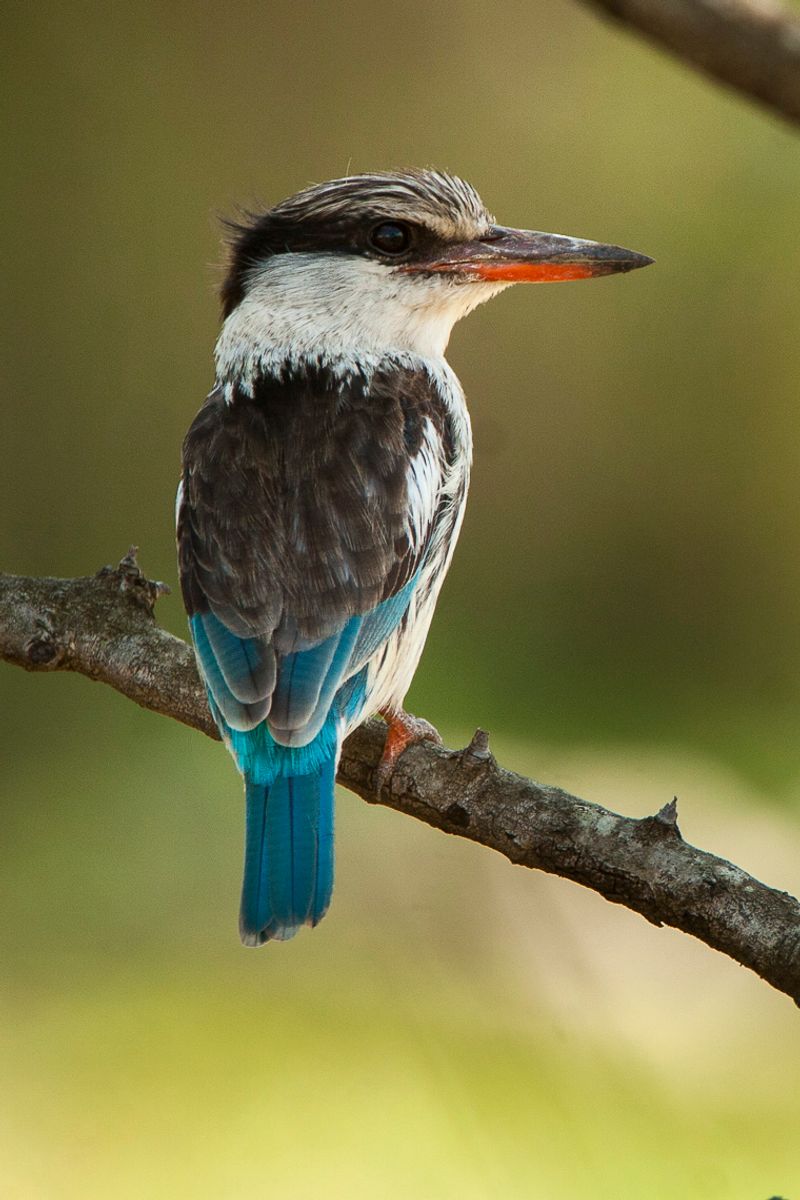
The striped kingfisher is a species of bird in the tree kingfisher subfamily. It was first described by Edward, Lord Stanley, in his book “Salt’s Voyage to Abyssinia” in 1814 under the name “Chelicut kingfisher” Alaudo Chelicuti.
The genus name Halcyon is derived from a bird in ancient Greek mythology, which is often associated with the kingfisher species.
In Greek mythology, the Halcyon was a bird that was said to have the power to calm the waters around an island in the Mediterranean Sea and breed in complete tranquility during the winter solstice.
This legend was used to describe the kingfisher, which is known for its ability to remain calm and peaceful even in the face of turbulence. The striped kingfisher is a species that is native to India, Sri Lanka, and parts of Africa.
It is a medium-sized bird, with a bright orange-red bill, a black-and-white striped head, and a bright blue back. It is an adept hunter, feeding on fish, insects, and even small rodents.
The striped kingfisher is an important part of the ecosystem, providing a natural balance in the environment. It is also a symbol of hope and resilience, as it has been able to survive even in the face of adversity.
It is also an important source of food for many people in the area, providing them with a sustainable source of nutrition.
The striped kingfisher is an iconic species, and the fact that it was first described by Edward, Lord Stanley in his book “Salt’s Voyage to Abyssinia” in 1814 is a testament to its importance.
Its genus name Halcyon is a reminder of its symbolic power, and its ability to remain calm and peaceful even in the face of turbulence.
| Kingdom | Animalia |
| Phylum | Chordata |
| Class | Aves |
| Order | Coraciiformes |
| Family | Alcedinidae |
| Genus | Halcyon |
| Species | H. chelicuti |
25. White-Bellied Bustard
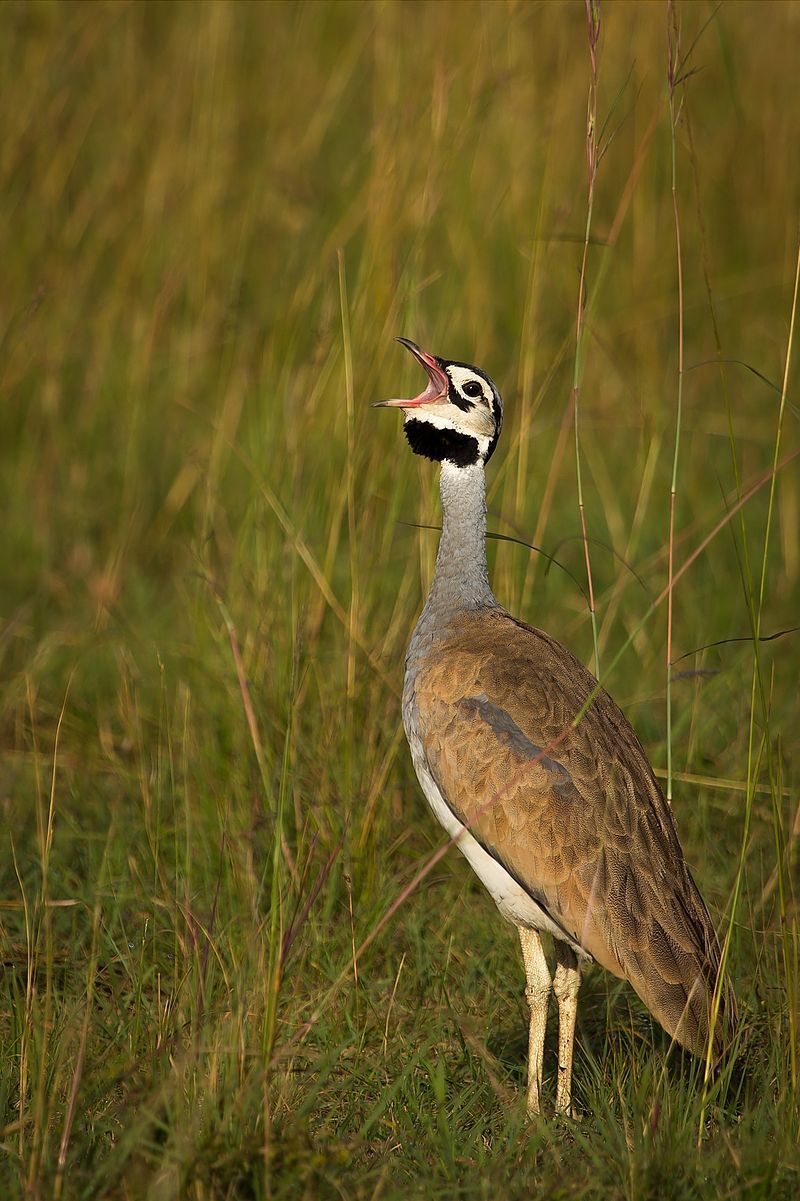
The white-bellied bustard, also known as the white-bellied korhaan, is a species of bustard found throughout sub-Saharan Africa. This species of bustard is known for its distinctive white belly, which stands out against its brown and black feathers.
It prefers to inhabit grassland and open woodland habitats, where it can feed on insects, small reptiles, and other small creatures. This species is a ground-dwelling bird, and typically prefers to stay close to the ground to avoid being seen by predators.
The white-bellied bustard is known to have good eyesight and can detect predators at a distance. This bird is also capable of running and flying away quickly when it senses danger.
The white-bellied bustard is an important part of the African ecosystem, as it helps control the population of small creatures such as insects and reptiles.
This species of bustard is also important for its aesthetic value, as its white belly gives it a unique and eye-catching appearance. The white-bellied bustard is an important part of the African bird population, and is an important species to protect and conserve.
| Kingdom | Animalia |
| Phylum | Chordata |
| Class | Aves |
| Order | Otidiformes |
| Family | Otididae |
| Genus | Eupodotis |
| Species | E. senegalensis |
26. Rufous-Bellied Heron
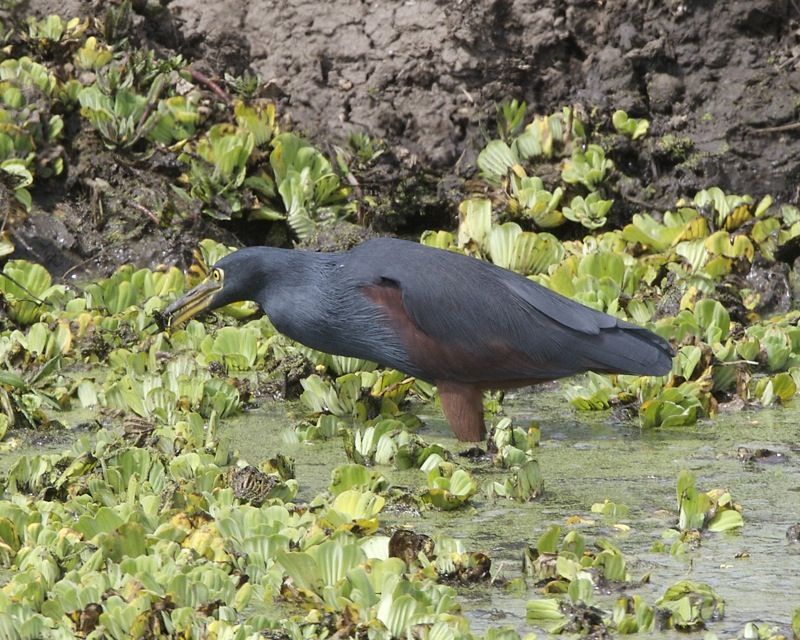
The rufous-bellied heron is a species of heron that belongs to the Ardeola genus, which is part of the Ardeidae family. This family of herons, known as the pond herons, can be found in sub-Saharan Africa, India, and Southeast Asia.
They are medium-sized wading birds, with a length of up to 66 cm and a wingspan of up to 90 cm. The rufous-bellied heron has a distinctive plumage, with its head and neck being a light grey-brown, its belly and breast a rufous-brown, and its back and wings a dark grey-brown.
They have a black bill, yellow eyes, and long black legs. They have a distinctively white throat and chin, as well as a black stripe on their cheeks. The rufous-bellied heron feeds on fish, aquatic insects, frogs, and crustaceans.
They are usually found in shallow wetlands and rivers, and can often be seen standing in the water or perched on rocks or branches.
They are solitary birds, only gathering in small groups during breeding season. The rufous-bellied heron is an important species for wetlands and rivers, as they help to keep the aquatic ecosystem in balance.
They are also an important part of the food web, as they provide prey for larger predators. Unfortunately, this species is vulnerable to habitat destruction and pollution, and their numbers are decreasing in many parts of the world.
| Kingdom | Animalia |
| Phylum | Chordata |
| Class | Aves |
| Order | Pelecaniformes |
| Family | Ardeidae |
| Genus | Ardeola |
| Species | A. rufiventris |
27. Bare-Faced Go-Away-Bird
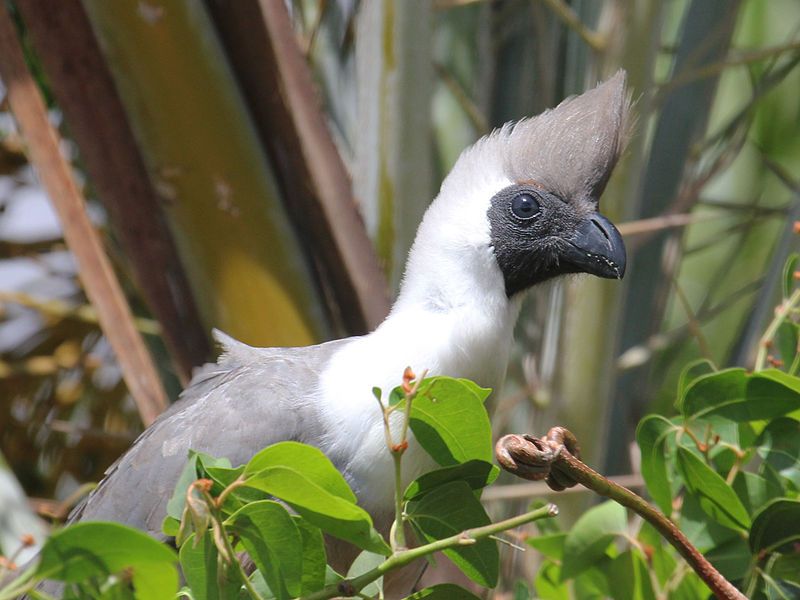
The bare-faced go-away-bird is an interesting species of bird that can be found in the eastern part of the Afrotropics. This species belongs to the family Musophagidae, and it is easily identified by its distinctive black face that is completely bare of feathers.
The name of this bird is fitting, as its call is said to sound like it is saying “go away”. It is a medium-sized bird, with a beautiful blue-gray coloration on its wings and back. Its tail is black, and its legs and beak are black as well.
The bare-faced go-away-bird is also known for its long, curved bill and its habit of perching on the tips of branches and twigs. This species of bird is found in woodlands, savannas, and open areas, where it feeds on fruits, insects, and small reptiles.
It is a solitary bird and usually seen alone or in pairs. It is an active bird and will often take flight in search of food. The bare-faced go-away-bird is an interesting species that has adapted to its habitat in a unique way.
It has a unique appearance and distinctive call that makes it stand out from other birds. It is an important part of the eastern Afrotropics and an interesting species to observe.
| Kingdom | Animalia |
| Phylum | Chordata |
| Class | Aves |
| Order | Musophagiformes |
| Family | Musophagidae |
| Genus | Crinifer |
| Species | C. personatus |
28. White-Browed Coucal
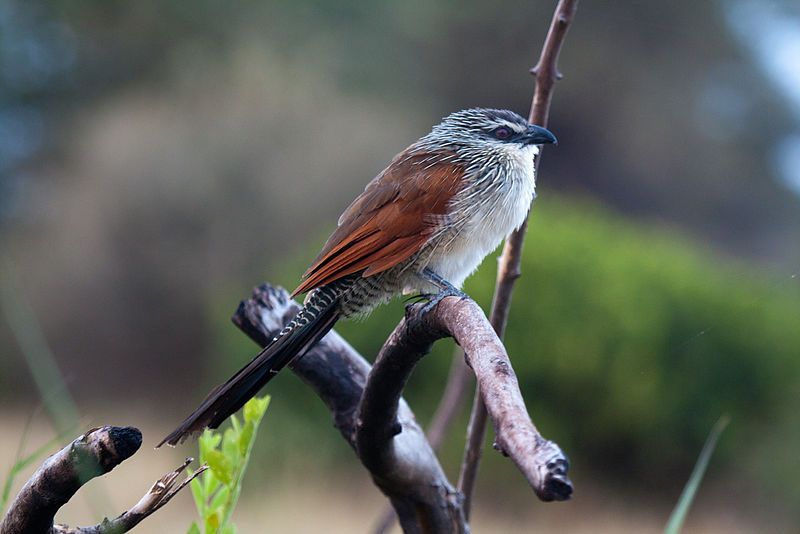
The white-browed coucal is a species of bird in the family Cuculidae, which is commonly known as the cuckoo. It is native to sub-Saharan Africa, where it can be found in a variety of habitats including coastal regions and areas with thick vegetation.
The white-browed coucal is closely related to Burchell’s coucal, a subspecies of the same family, which may also be found in parts of sub-Saharan Africa.
This species of cuckoo is known to occupy areas with rank undergrowth and scrub, providing the bird with dense cover for protection and a rich source of food.
The white-browed coucal is an important species in the region and is especially noted for its distinctive white eyebrow markings and its call, which consists of a series of deep, hollow notes.
| Kingdom | Animalia |
| Phylum | Chordata |
| Class | Aves |
| Order | Cuculiformes |
| Family | Cuculidae |
| Genus | Centropus |
| Species | C. superciliosus |
29. Malachite Kingfisher
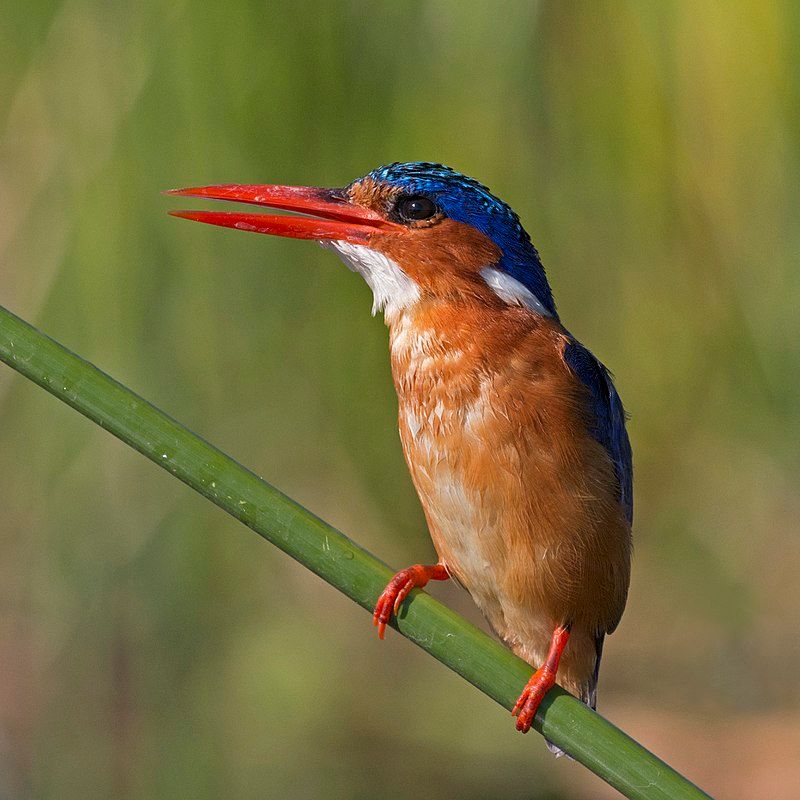
The Malachite Kingfisher is a species of kingfisher that is native to Africa south of the Sahara Desert. It is usually a permanent resident of the same area, but it may make seasonal migrations in response to changes in the climate.
This bird typically inhabits wetlands and rivers and can be found in a variety of habitats, from woodlands to savannahs. It is a small bird, measuring about 18 to 20 cm in length, and it has a bright blue back, head, and wings, with a white belly and chest.
The head and breast are bright turquoise in color, while the bill is dark. It is a solitary bird, but it may gather together in small groups when breeding. The Malachite Kingfisher is a carnivore, and it feeds mainly on small fish, aquatic insects, and crustaceans.
It typically hunts by perching on a branch or rock near the water’s edge, before diving down into the water to catch its prey. It also sometimes feeds on land, taking small amphibians and reptiles.
Breeding typically occurs between August and October, and the female typically lays 3 to 5 eggs in a nest that is made in a hole in a tree or in a bank.
The male has an elaborate courtship display, which involves diving from a high perch and calling loudly. Overall, the Malachite Kingfisher is an attractive and interesting species of bird, and it is widely distributed in Africa south of the Sahara.
Its presence is an important part of the local ecology, and it is an important indicator of the health of the aquatic ecosystem.
| Kingdom | Animalia |
| Phylum | Chordata |
| Class | Aves |
| Order | Coraciiformes |
| Family | Alcedinidae |
| Genus | Corythornis |
| Species | C. cristatus |
30. Black-Headed Heron
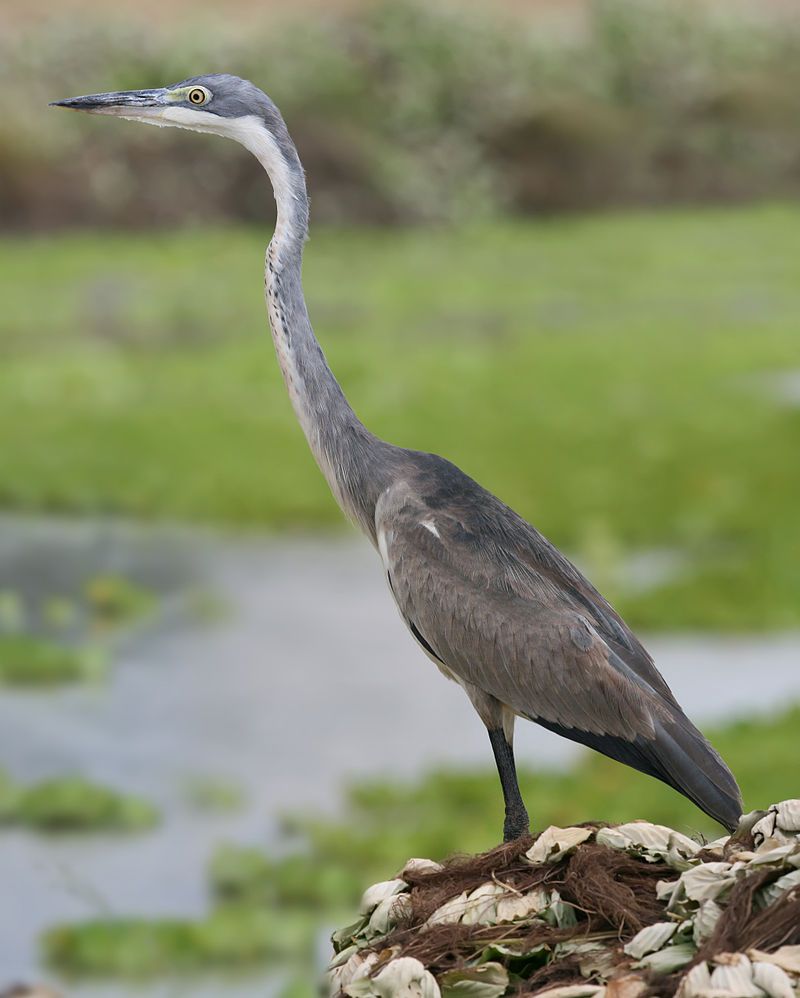
The black-headed heron is an aquatic bird that belongs to the Ardeidae family, which is found in many regions of sub-Saharan Africa and Madagascar.
It generally lives in the same area year-round, but some of the herons located in West Africa migrate to more northern areas during the wet season. During the wet season, black-headed herons form colonies in trees, reed beds, or cliffs and use them to breed.
These colonies often contain hundreds of herons, which can make quite a spectacle. The black-headed heron feeds mainly on small fish, frogs, and insects, which it catches in shallow water by standing still and waiting for its prey to come close.
This species of heron is an important part of many African ecosystems and plays an important role in the food web.
| Kingdom | Animalia |
| Phylum | Chordata |
| Class | Aves |
| Order | Pelecaniformes |
| Family | Ardeidae |
| Genus | Ardea |
| Species | A. melanocephala |
31. Little Bee-Eater
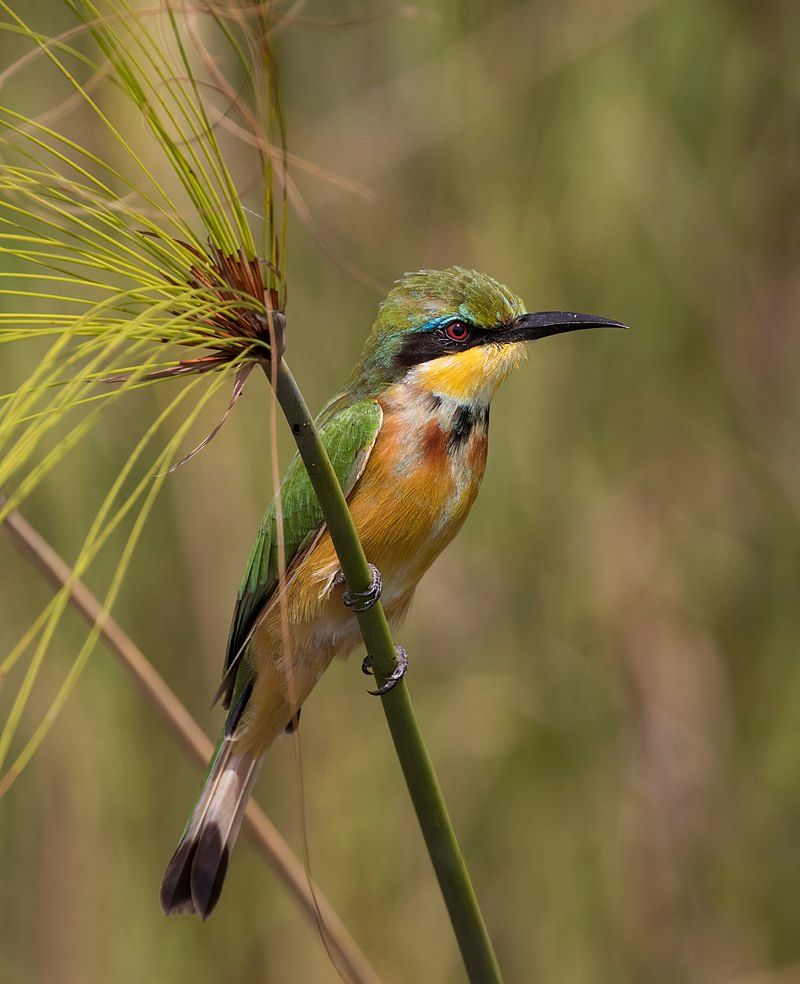
The little bee-eater is a type of near-passerine bird from the bee-eater family, Meropidae.
It is native to Sub-Saharan Africa and can be easily distinguished from its close relative, the little green bee-eater, by its bright colors. Little bee-eaters feed mainly on insects, particularly bees, and are usually found flocking around flowers or other sources of food.
They typically have a strong affinity for open savanna and light woodland habitats. When it comes to migration, little bee-eaters are more limited in their movements.
They generally migrate based on the changing rainfall patterns in their local area, so they tend to stay in the same area for a longer period of time.
This is why they are found in the same place throughout the year, even if the climate can become very dry. The little bee-eater is an interesting species of bird that is found in Sub-Saharan Africa.
It has a unique set of behaviors that distinguish it from other bee-eaters, such as its reliance on seasonal rainfall patterns for migration. This species of bird is a great example of how nature works to ensure that species can survive and thrive in their given environment.
| Kingdom | Animalia |
| Phylum | Chordata |
| Class | Aves |
| Order | Coraciiformes |
| Family | Meropidae |
| Genus | Merops |
| Species | M. pusillus |
32. Crowned Lapwing
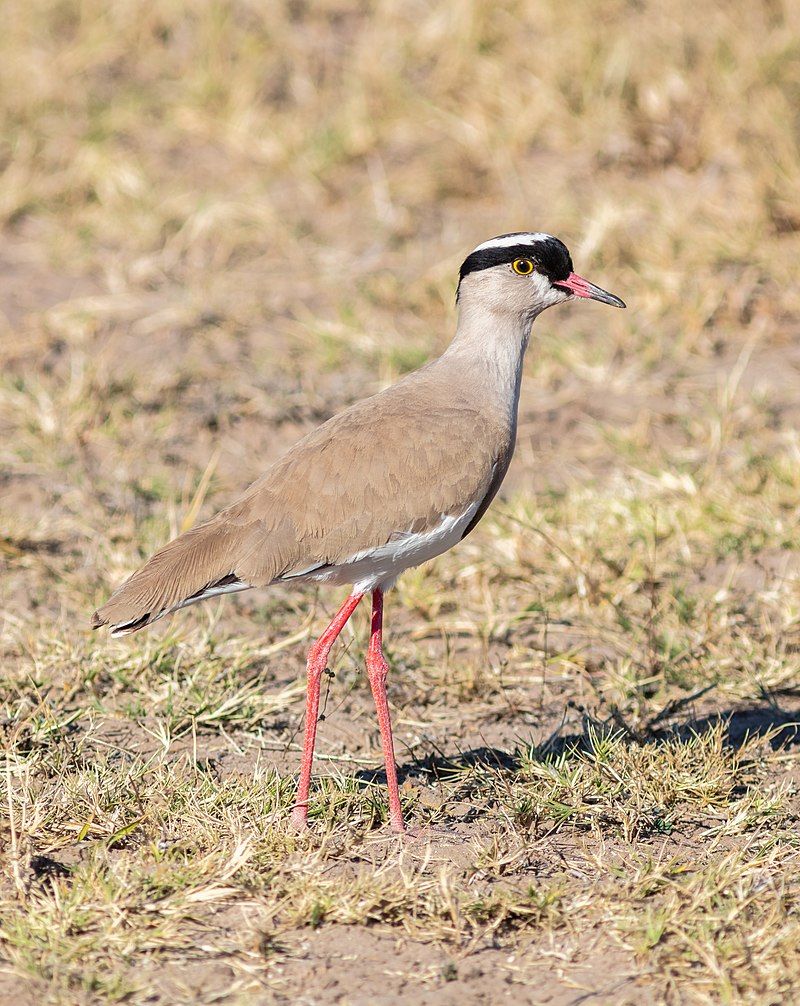
The crowned lapwing, also known as the crowned plover, is a species of bird that is part of the lapwing subfamily. This bird can be found in a wide range of habitats, stretching from the Red Sea coast of Somalia in the east all the way to southern and southwestern Africa.
It is an abundant and adaptable species, capable of adapting to a variety of habitats. It is also very vocal and is known for its bold and noisy behavior. The crowned lapwing is mainly a scavenger, although it will also hunt for food when necessary.
It is also an active and agile flier, and is also known for its aerial acrobatics. The crowned lapwing often forms large flocks, which can be seen foraging in grasslands, open woodlands, wetlands, and even in urban areas.
Its diet consists of a variety of small animals, such as insects, worms, and other invertebrates, as well as seeds and fruits. The crowned lapwing is a highly social species and is often seen in mixed-species flocks, where it is known for its aggressive behavior.
| Kingdom | Animalia |
| Phylum | Chordata |
| Class | Aves |
| Order | Charadriiformes |
| Family | Charadriidae |
| Genus | Vanellus |
| Species | V. coronatus |
33. Black-Bellied Bustard
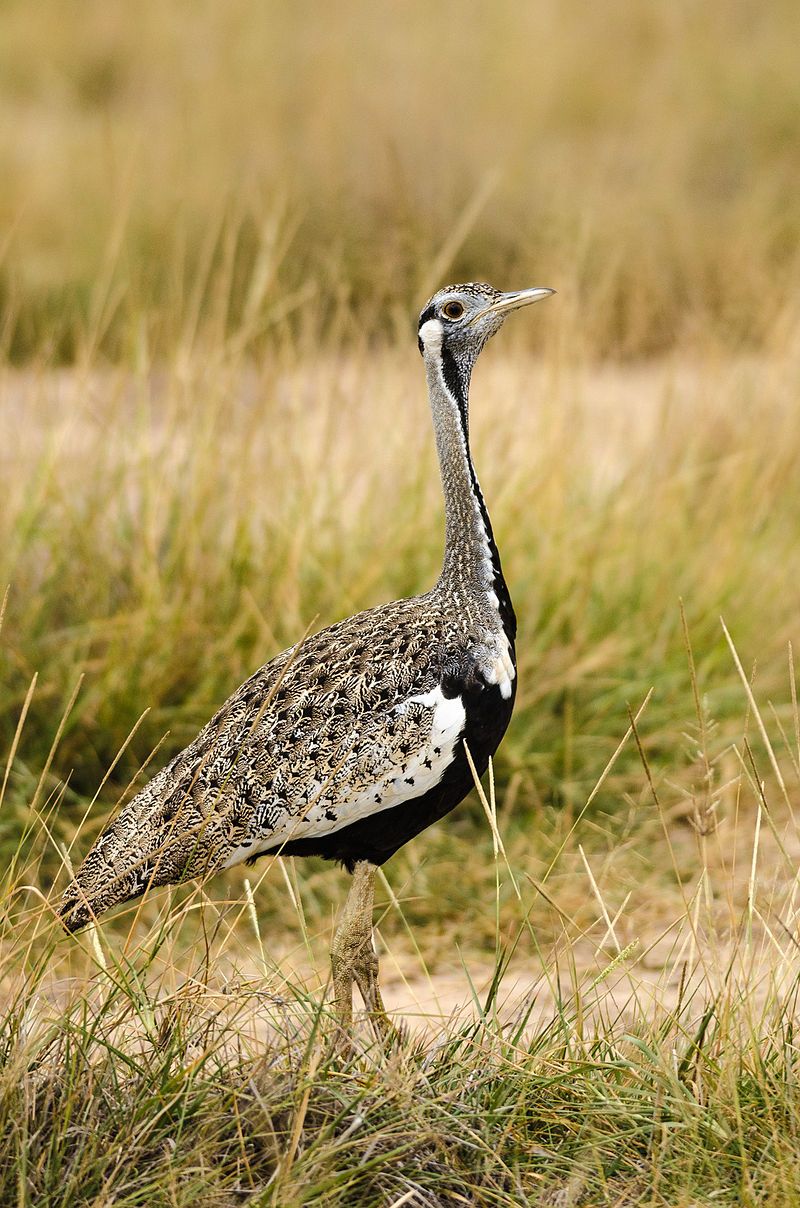
The black-bellied bustard, also known as the black-bellied korhaan, is a species of bird native to Africa. It belongs to the bustard family, which is made up of large, terrestrial birds found across the continent.
The black-bellied bustard is a ground-dwelling bird, which means it is adapted to living on the ground rather than in trees or other structures. It is mostly found in open grassland and savanna habitats, where it forages on the ground for small insects and other food sources.
The black-bellied bustard is a medium-sized bird, usually with a brown or grey body and white-tipped wings. Its most distinctive feature is the black belly, which gives it its name.
The black-bellied bustard is an important species to the African ecosystem, as it helps to disperse seeds and control insect populations. It is also an important species to the local people, who often hunt the bird for its meat.
As a result, the species is classified as Near Threatened on the IUCN Red List of Threatened Species.
| Kingdom | Animalia |
| Phylum | Chordata |
| Class | Aves |
| Order | Otidiformes |
| Family | Otididae |
| Genus | Lissotis |
| Species | L. melanogaster |
34. Cardinal Woodpecker
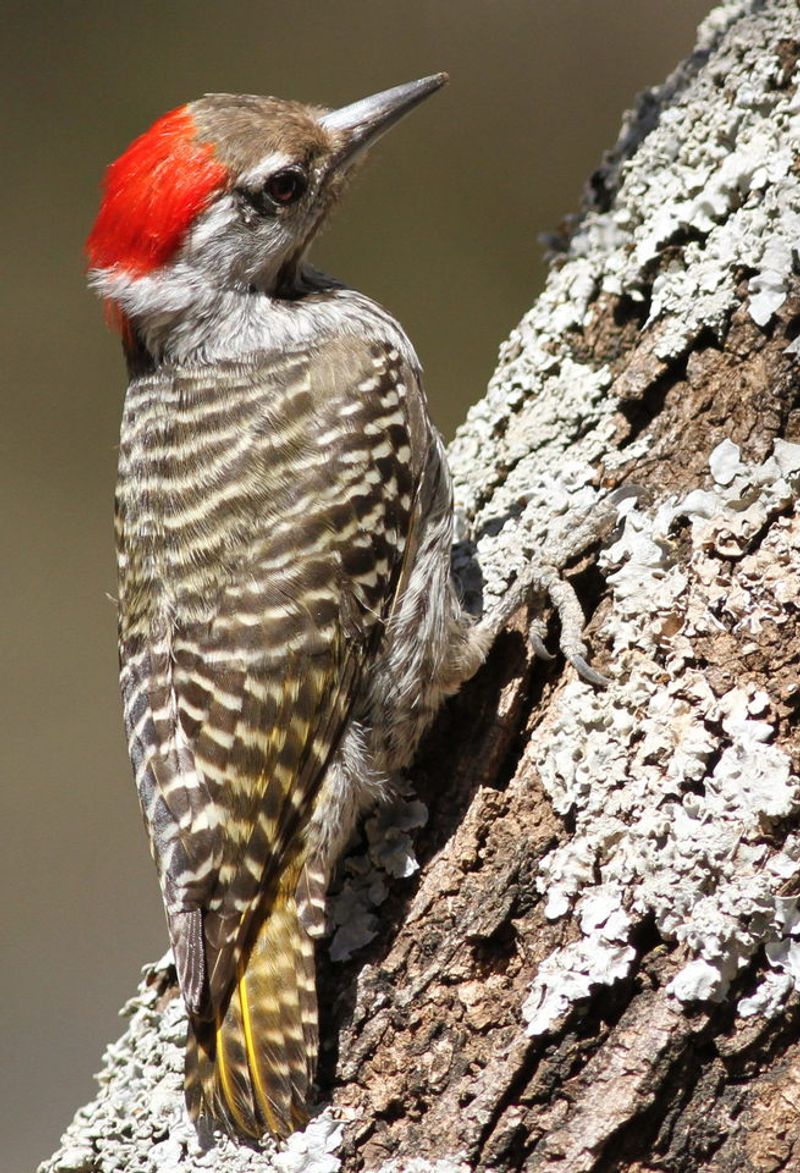
The cardinal woodpecker is a species of woodpecker that is found mainly in sub-Saharan Africa. It is a widespread and common resident breeder, meaning that it will stay in the same area to breed throughout the year.
It can live in a wide range of habitats, from dense forests to sparsely grown thorn bushes. The cardinal woodpecker is quite vocal and can be easily recognized by its distinct call notes.
In addition, the male and female cardinal woodpeckers can be identified by their different head patterns. The male has a red head and face, while the female has a black head and face.
This species of woodpecker is a crucial part of the African ecosystem, helping to control insect numbers and dispersing tree seeds.
| Kingdom | Animalia |
| Phylum | Chordata |
| Class | Aves |
| Order | Piciformes |
| Family | Picidae |
| Genus | Dendropicos |
| Species | D. fuscescens |
35. Red-Capped Lark
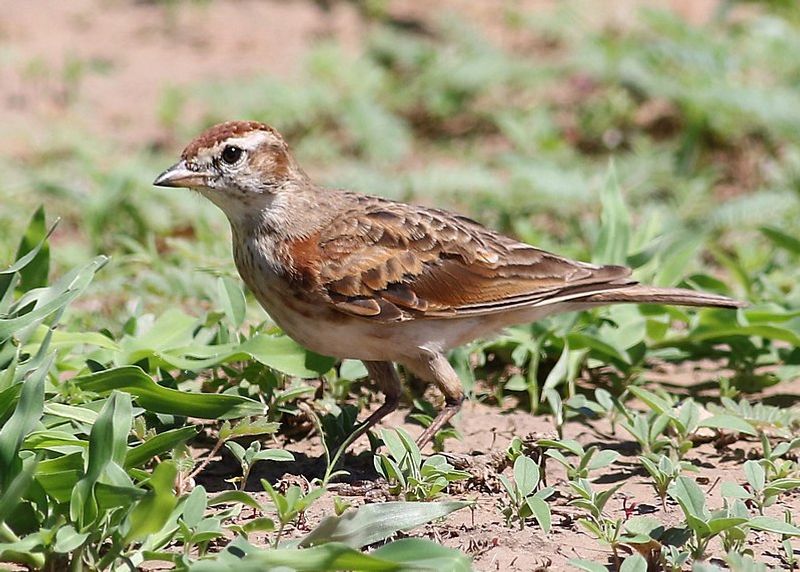
The red-capped lark is a species of small passerine bird that is native to the highlands of Eastern Africa. Its range stretches from Ethiopia and Somaliland in the north, all the way south to Angola and the Cape in South Africa.
This species of lark is generally found in open country, typically inhabiting areas of grassland, scrub, and semi-arid savannahs. It is highly terrestrial and feeds on insects and seeds.
During the breeding season, the male lark will sing from a high perch in order to attract a mate. The red-capped lark is an overall common species and is not currently considered threatened.
| Kingdom | Animalia |
| Phylum | Chordata |
| Class | Aves |
| Order | Passeriformes |
| Family | Alaudidae |
| Genus | Calandrella |
| Species | C. cinerea |
36. Speckled Pigeon
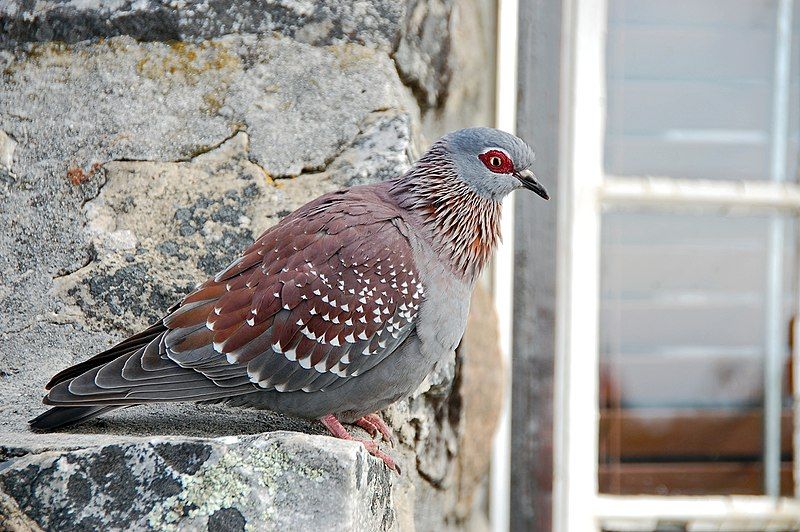
The Speckled Pigeon is a species of bird that is native to much of Africa south of the Sahara. It is a type of African Rock Pigeon or Guinea Pigeon and is a common sight in open habitats like fields and grasslands.
These birds are well-distributed over their range, although there are some areas where they are not found. They have speckled brown and grey plumage and can sometimes be seen in pairs or in small flocks.
They feed mainly on grains and seeds found in the ground, and are also known to eat insects. They breed in the warmer months, usually nesting in trees or other tall structures.
The Speckled Pigeon is an important species in the African environment, as it plays a role in the seed dispersal of some plant species.
| Kingdom | Animalia |
| Phylum | Chordata |
| Class | Aves |
| Order | Columbiformes |
| Family | Columbidae |
| Genus | Columba |
| Species | C. guinea |
37. Harlequin Quail
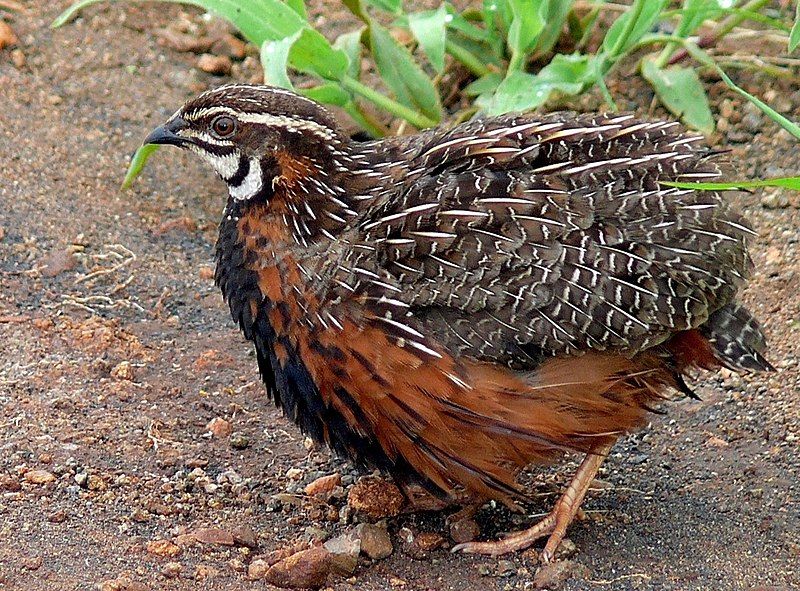
The Harlequin Quail is a species of bird that belongs to the Phasianidae family. These birds are mainly found in sub-Saharan Africa and the Arabian Peninsula.
The species was named after Adulphe Delegorgue, a French naturalist who collected specimens of the bird during his travels in the region. The Harlequin Quail is a small bird, measuring around 14 cm in length. It is mainly brown with a red patch on its back.
The males have a black-and-white breast, while the females are red-brown. These birds usually live in pairs and are found in grassland habitats. They feed on seeds, grasses, and insects.
The Harlequin Quail is considered to be a threatened species due to habitat destruction and overhunting. Conservation efforts are ongoing to ensure the species’ survival.
| Kingdom | Animalia |
| Phylum | Chordata |
| Class | Aves |
| Order | Galliformes |
| Family | Phasianidae |
| Genus | Coturnix |
| Species | C. delegorguei |
38. Spur-Winged Lapwing
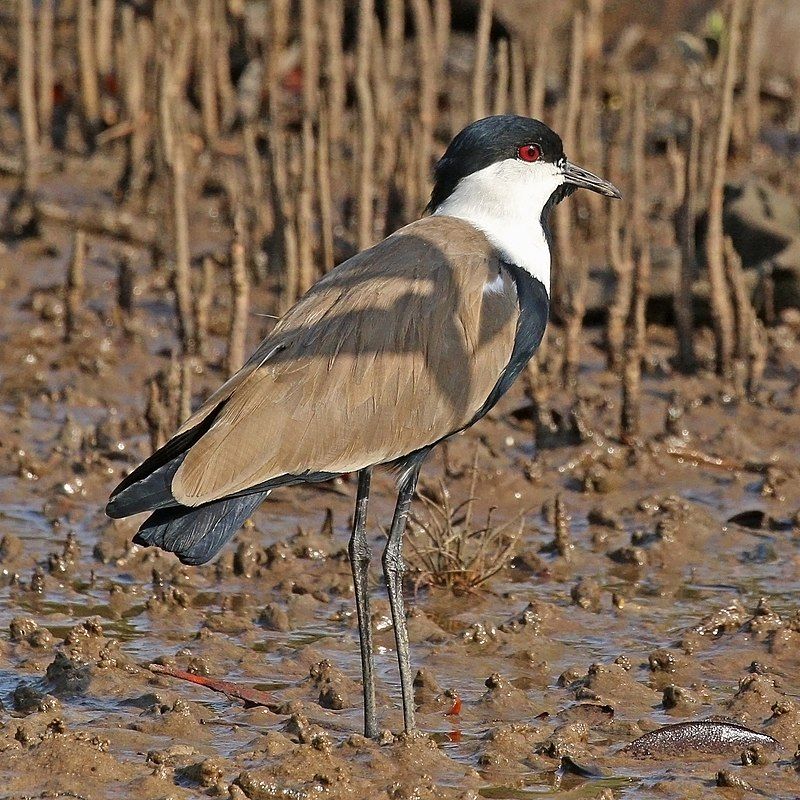
The spur-winged lapwing or spur-winged plover is a species of wading bird, which belongs to the family Charadriidae. It is a fairly large bird with a wingspan of up to 32 inches and a weight of up to 8 ounces.
The species is native to Africa and the Middle East, where it is found in open grasslands and other open habitats. The spur-winged lapwing is thought to be the “trochilus” bird mentioned by the ancient Greek historian Herodotus.
According to Herodotus, the trochilus bird was involved in a unique cleaning symbiosis with the Nile crocodile. The crocodile would open its jaws wide, and the trochilus bird would enter and feed on parasites and other small animals found in the crocodile’s mouth.
In return, the crocodile was given a thorough cleaning of its teeth and gums. Although there is no scientific evidence to back up this story, the spur-winged lapwing is still considered a likely candidate for the trochilus bird.
The species does have a habit of entering the mouths of large animals, such as gazelle and buffalo, and picking at their teeth and gums, probably to remove parasites and other food items.
This behavior could explain the ancient story of a cleaning symbiosis between a bird and a crocodile. Overall, the spur-winged lapwing is an interesting species of wading bird due to its unique behavior and its potential connection to the ancient story of cleaning symbiosis.
It is a species that is worth learning more about in order to better understand its role in the natural world.
| Kingdom | Animalia |
| Phylum | Chordata |
| Class | Aves |
| Order | Charadriiformes |
| Family | Charadriidae |
| Genus | Vanellus |
| Species | V. spinosus |
39. Red-Necked Spurfowl
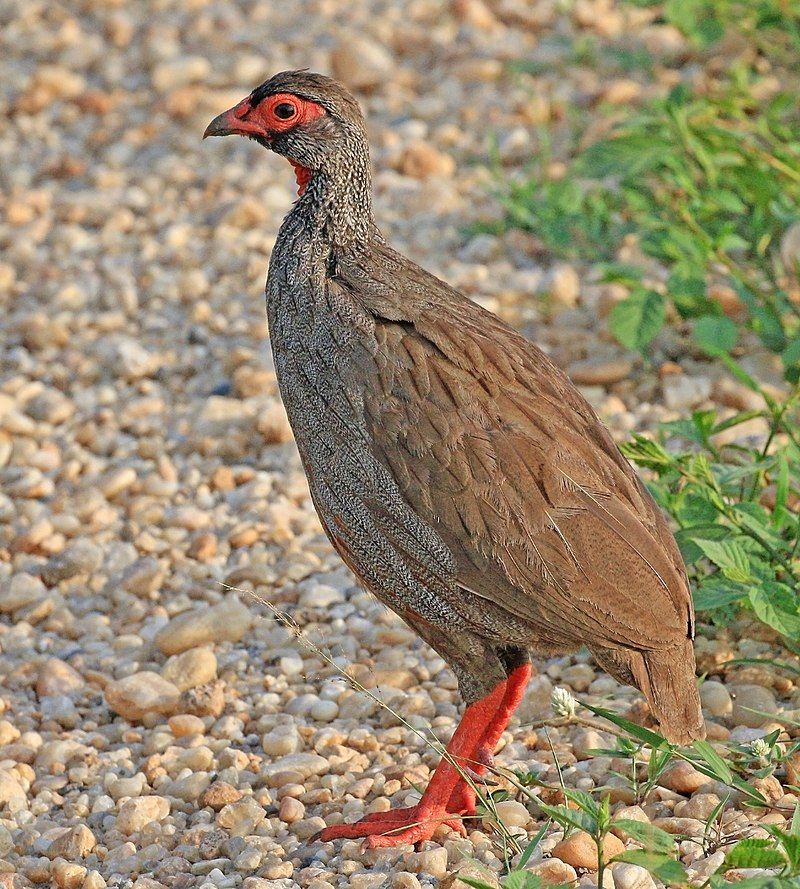
The red-necked spurfowl, also known as the red-necked francolin, is a species of gamebird found in southern Africa. It is a member of the pheasant family, Phasianidae.
This species is a resident of the African continent, meaning it does not migrate but stays in the same region throughout its life. The red-necked spurfowl is a medium-sized bird, usually measuring around 30 centimeters in length.
Its plumage is mostly brown, with some white and black markings. Its most distinctive feature is its red neck, which is what gives it its name.
The legs of this species are short and strong, which allows it to move quickly through dense vegetation. The red-necked spurfowl is primarily a ground-dweller, living and foraging in grasslands and woodlands. It feeds on a variety of seeds, insects, and other small invertebrates.
It is also known to eat some fruit and vegetation. The red-necked spurfowl is also known to take advantage of cultivated crops, making it a pest species in some areas. This species is usually found in pairs or small groups.
During the breeding season, the male will establish a territory and will call to attract a mate. The female will lay her eggs in a shallow nest on the ground, and both parents will take turns incubating them.
The chicks are capable of feeding themselves and will leave the nest after a few days. The red-necked spurfowl is not considered to be at risk of extinction. It has a wide range and can adapt to various habitats. However, it is still hunted for food and sport in some areas.
| Kingdom | Animalia |
| Phylum | Chordata |
| Class | Aves |
| Order | Galliformes |
| Family | Phasianidae |
| Genus | Pternistis |
| Species | P. afer |
40. African Grey Woodpecker
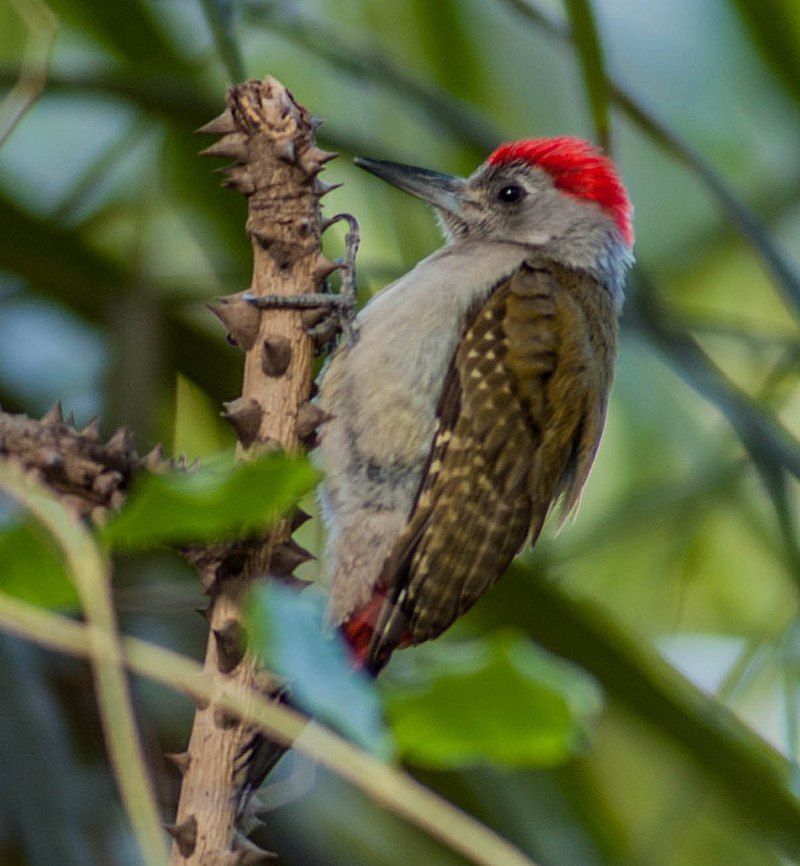
The African grey woodpecker is a species of bird in the woodpecker family Picidae and is commonly found throughout Sub-Saharan and equatorial Africa. It inhabits both forests and bush areas and builds its nests in tree holes, often in oil palms.
When breeding, it lays two to four eggs. This species is quite widespread and usually quite common in its natural habitat. This woodpecker is an important part of the African ecosystem, as it helps to disperse seeds and insects, aiding in the regeneration of the forest.
Its diet consists of both insects and fruit, which it obtains from trees and bushes. It is also a popular bird among bird watchers and photographers, due to its distinct calls and bold colors. The African grey woodpecker is a unique species in the Picidae family.
Its abilities to adapt to its environment and its willingness to coexist with humans make it an interesting species to study and observe. It is also a great example of how animals can survive and thrive in different habitats, even if those habitats aren’t exactly ideal.
As a result, it is an important part of the African ecosystem and should be appreciated and protected.
| Kingdom | Animalia |
| Phylum | Chordata |
| Class | Aves |
| Order | Piciformes |
| Family | Picidae |
| Genus | Dendropicos |
| Species | D. goertae |
41. Nubian Woodpecker
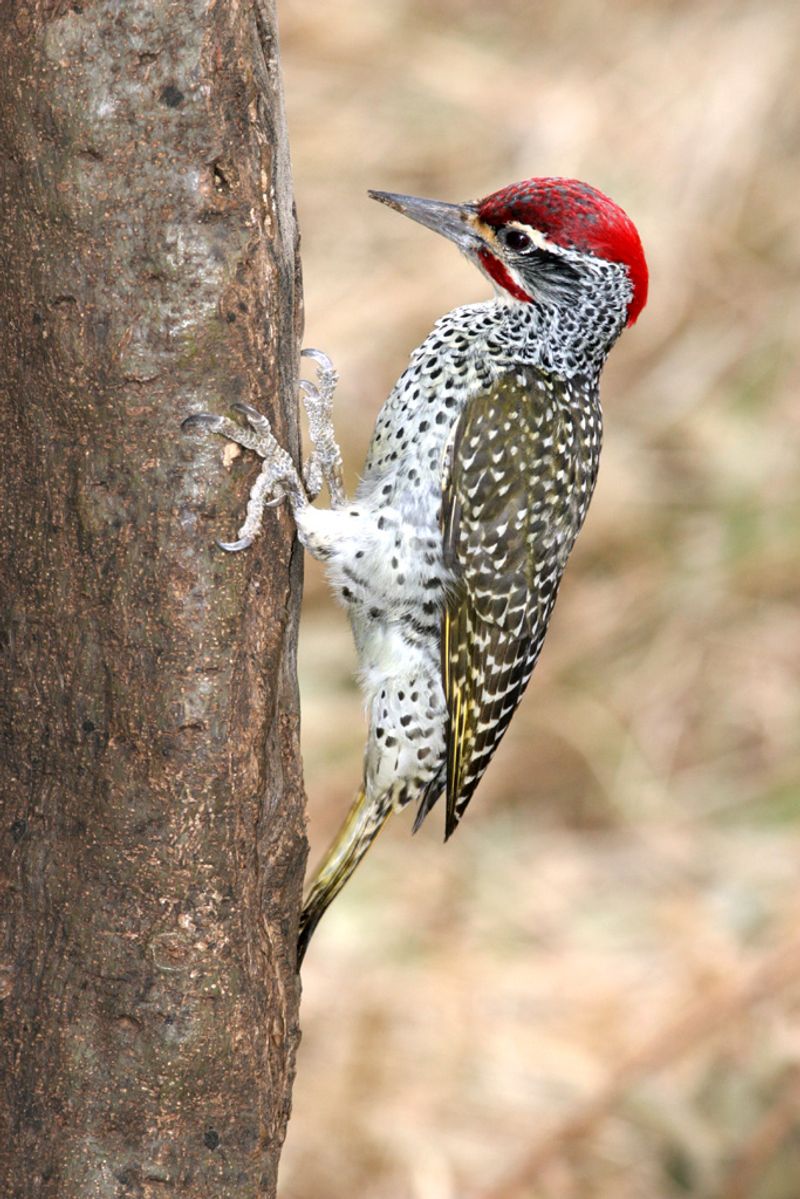
The Nubian woodpecker is a species of bird belonging to the Picidae family. It is found in many regions of Central and Eastern Africa, stretching from Chad in the west to Somalia in the east and Tanzania in the south.
This bird is found in a variety of habitats, from woodlands to savannas, and is known to feed on both insects and fruit. The Nubian woodpecker is easily recognizable by its white-tipped black wings and its yellow breast.
It is usually found in small groups and is an active forager. The Nubian woodpecker is an important species of bird in its native range, as it helps to control insect populations and disperses the seeds of fruit-bearing plants.
As a result, it plays an important role in the health and balance of local ecosystems.
| Kingdom | Animalia |
| Phylum | Chordata |
| Class | Aves |
| Order | Piciformes |
| Family | Picidae |
| Genus | Campethera |
| Species | C. nubica |
42. Western Banded Snake Eagle
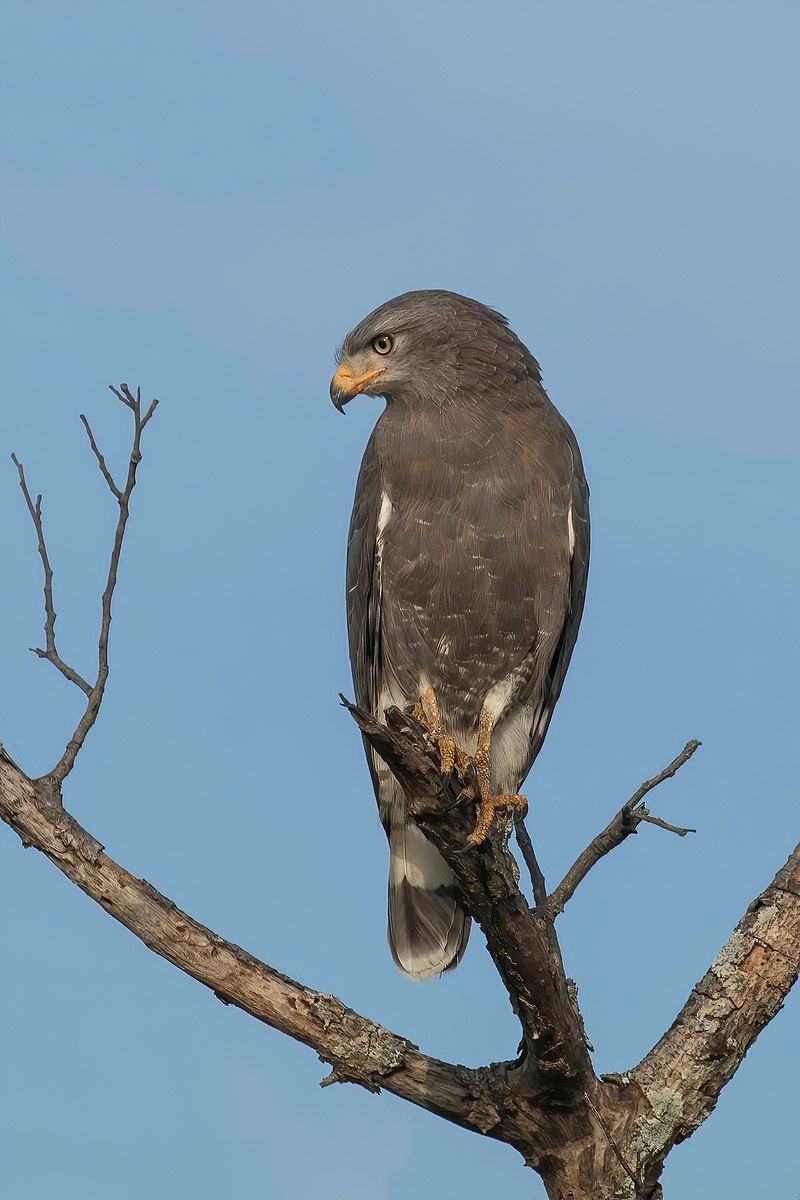
The western banded snake eagle is a grey-brown African raptor with a distinctive long and large head. Its upper parts are darker and more grey in adults, while juveniles have lighter brown feathers with white edges.
The head, neck and breast of the eagle are darkly streaked, while the underparts are white and have pale brown streaks, especially on the belly and thighs.
This coloration helps the eagle to blend in with its environment, making it more difficult for potential predators to spot it. The short tail of the eagle helps it to maneuver quickly and efficiently in the air, allowing it to swoop down to catch prey.
The eagle’s large head provides it with good eyesight, allowing it to spot prey from a great distance. All of these features make the western banded snake eagle a formidable hunter, and an important part of the African raptor population.
| Kingdom | Animalia |
| Phylum | Chordata |
| Class | Aves |
| Order | Accipitriformes |
| Family | Accipitridae |
| Genus | Circaetus |
| Species | C. cinerascens |
43. Augur Buzzard
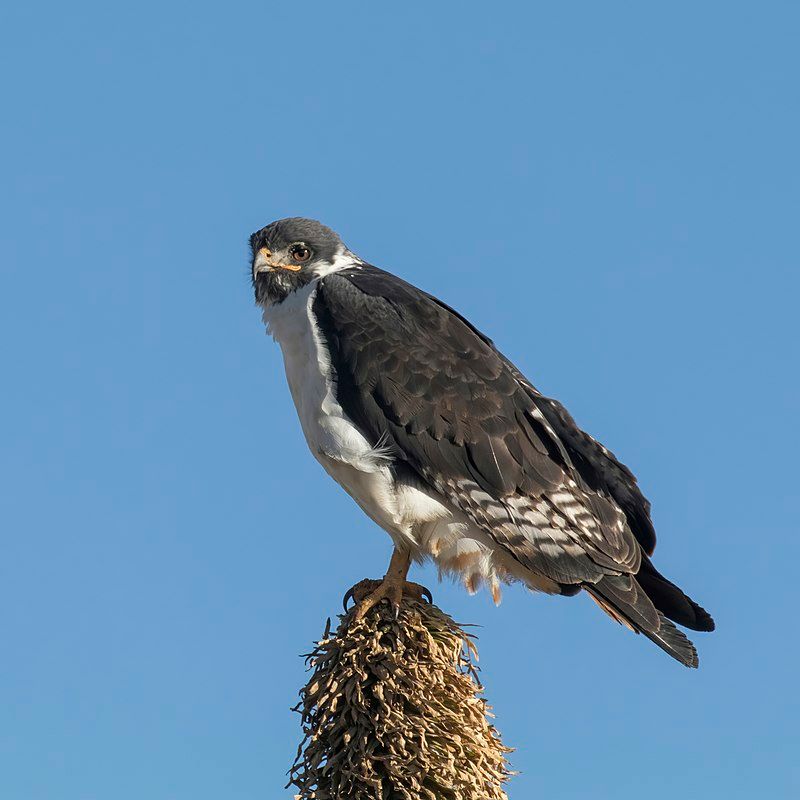
The augur buzzard is a species of bird of prey native to Africa. It has a unique coloration that makes it stand out from other birds of its kind. The typical adult plumage is characterized by a black back, whitish underside, and an orange-red tail.
There is also a dark morph of the species that has a darker coloration. Juveniles of the species tend to be browner in color than the adults, which helps them blend in with their environment more effectively. The augur buzzard is a fairly large bird, making it easy to spot.
Its distinctive color pattern allows it to be identified even from a distance.
| Kingdom | Animalia |
| Phylum | Chordata |
| Class | Aves |
| Order | Accipitriformes |
| Family | Accipitridae |
| Genus | Buteo |
| Species | B. augur |
44. African Hoopoe
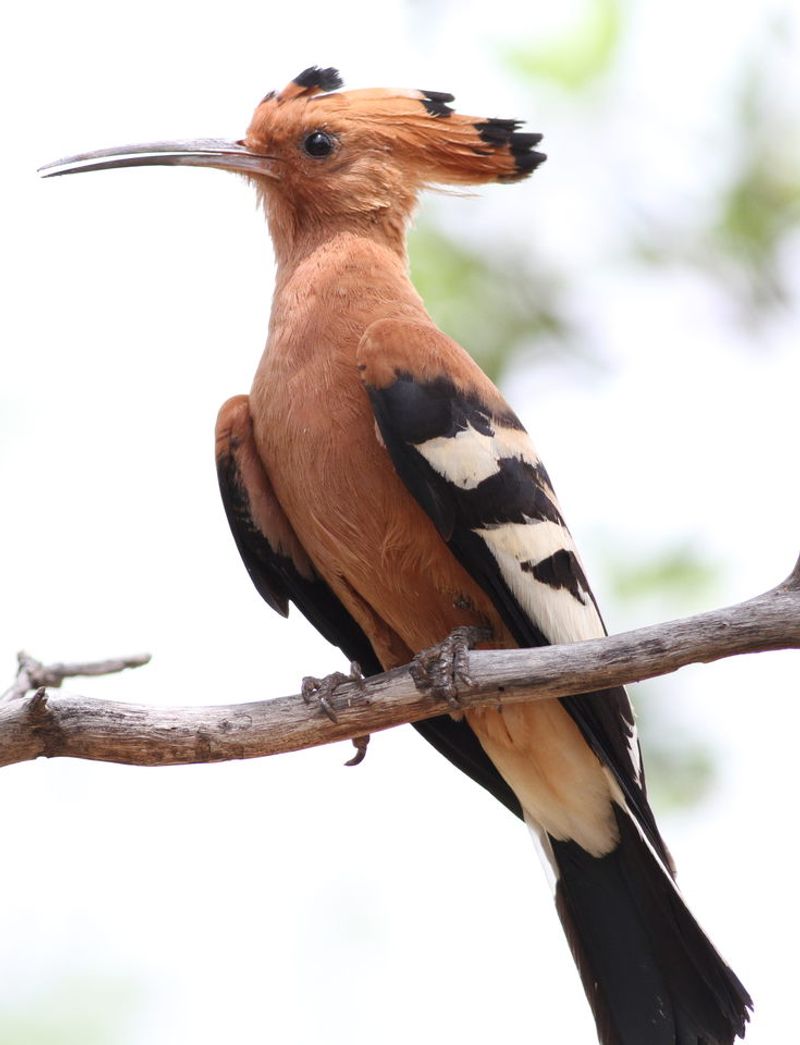
The African hoopoe is a species of bird in the family Upupidae. It was initially thought to be a subspecies of the Eurasian hoopoe, but now it is recognized as a distinct species.
The African hoopoe is a native of southern Africa, and is found in a variety of habitats, including open savannas, woodlands, and grasslands. It has a distinctive crest and a colorful plumage with a black-and-white pattern.
The African hoopoe feeds on a variety of insects and other invertebrates, as well as on fruit and seeds. It forages on the ground and in trees, and also digs for food in the soil.
The African hoopoe nests in cavities in trees and in abandoned buildings, and typically lays 2-3 eggs per clutch. Its population is stable overall, but it is threatened by habitat loss and fragmentation due to human activities such as agriculture and development.
| Kingdom | Animalia |
| Phylum | Chordata |
| Class | Aves |
| Order | Bucerotiformes |
| Family | Upupidae |
| Genus | Upupa |
| Species | U. africana |
45. Cinnamon-Chested Bee-Eater
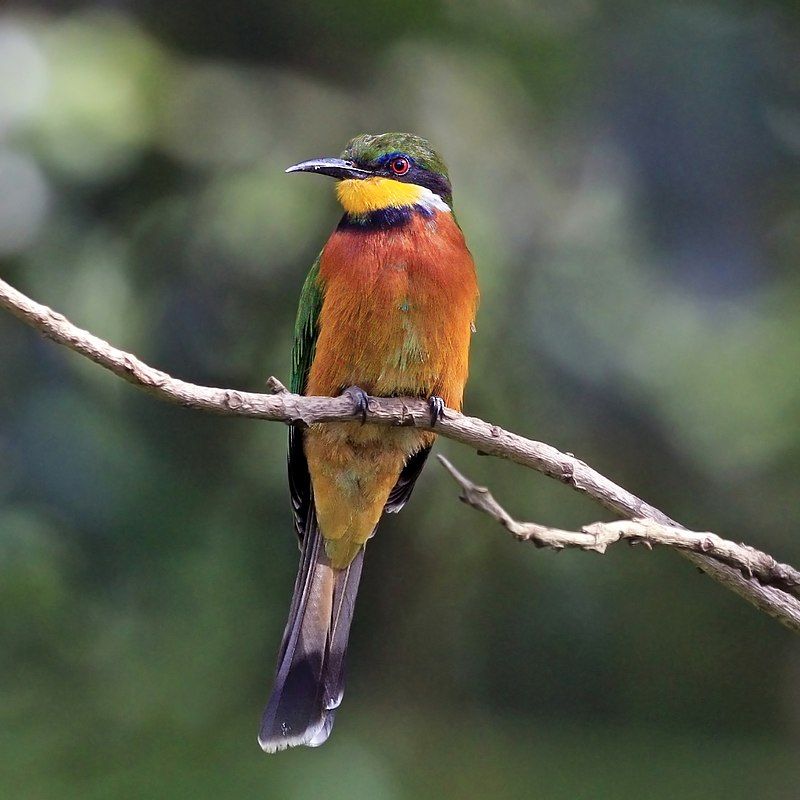
Source: Wikipedia
The cinnamon-chested bee-eater is a brightly colored bird species that belongs to the family Meropidae. It is native to East Africa and is found in a variety of habitats, from woodlands and forests to grasslands and savannahs.
These birds live in flocks and feed on bees, wasps, and other insects. The species is found in Burundi, Democratic Republic of the Congo, Ethiopia, Kenya, Rwanda, South Sudan, Tanzania, and Uganda. The cinnamon-chested bee-eater is easily identified by its striking plumage.
It has a cinnamon-colored chest, while its back and wings are chestnut-brown. The throat and forehead are blue, while the underside of its tail feathers are white. The beak is black and long, allowing it to catch its insect prey with ease.
These birds are monogamous and generally nest in the ground. They make their nests in sandy areas and lay about four to five eggs at a time. The female incubates the eggs for about two weeks before the chicks hatch.
The parents take turns feeding the chicks until they are ready to leave the nest. The cinnamon-chested bee-eater is a unique and beautiful species of bird that plays an important role in its East African habitat.
It helps to keep the insect population in check by feeding on bees and other flying insects. Unfortunately, the species is threatened by habitat loss and degradation, and its population is declining. Conservation efforts are needed to ensure the future of this species.
| Kingdom | Animalia |
| Phylum | Chordata |
| Class | Aves |
| Order | Coraciiformes |
| Family | Meropidae |
| Genus | Merops |
| Species | M. oreobates |
Conclusion
Birds in the Mara region are a vital part of the local ecology and culture. They help to maintain the balance of the ecosystem, provide food for humans and other animals, and have been an important part of the area’s history and culture for centuries.
Though their numbers have been in decline due to human activity, conservation efforts are helping to protect them and ensure their continued presence in the Mara region.